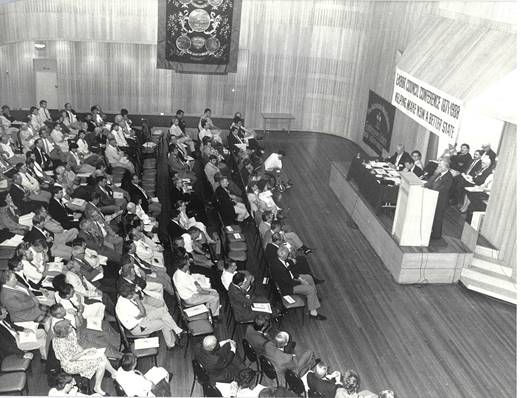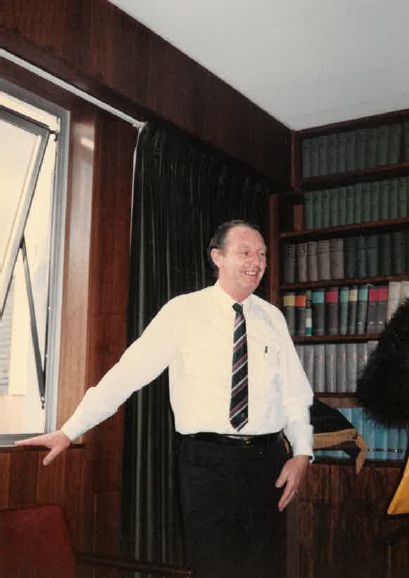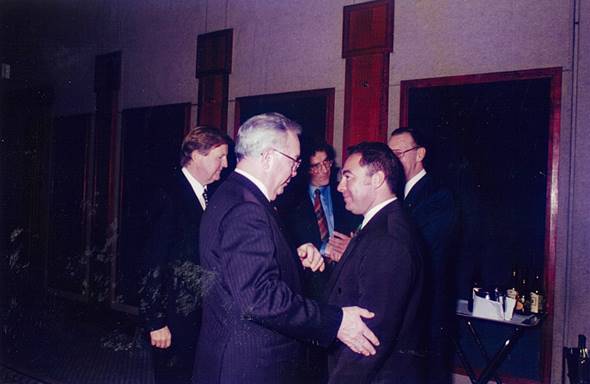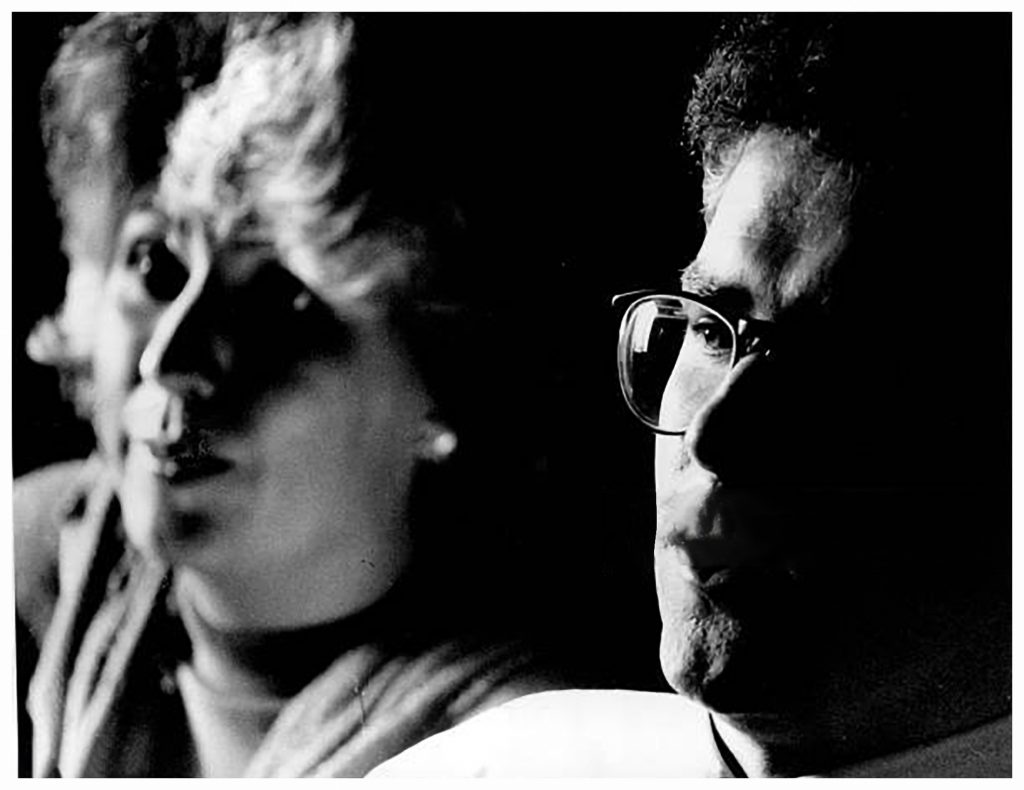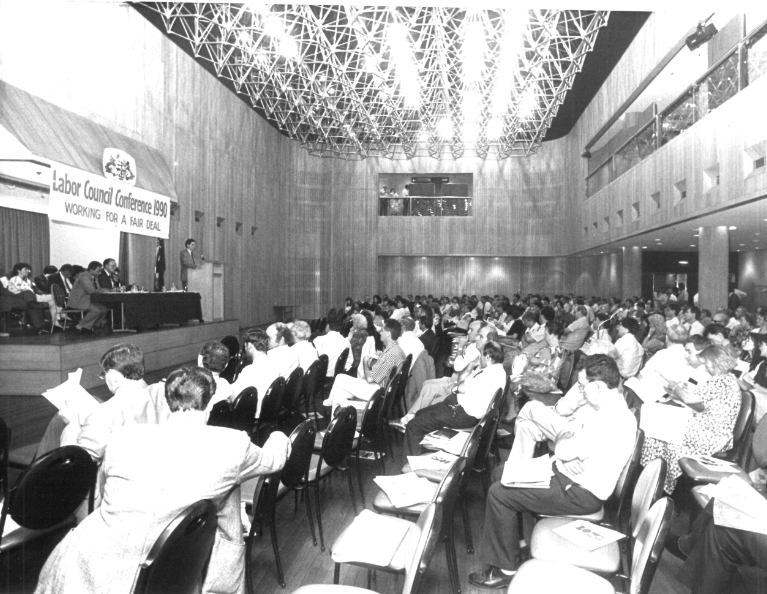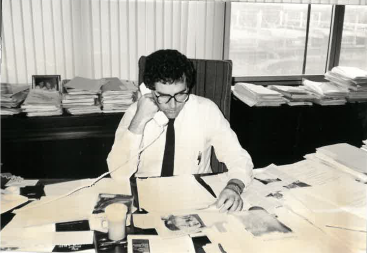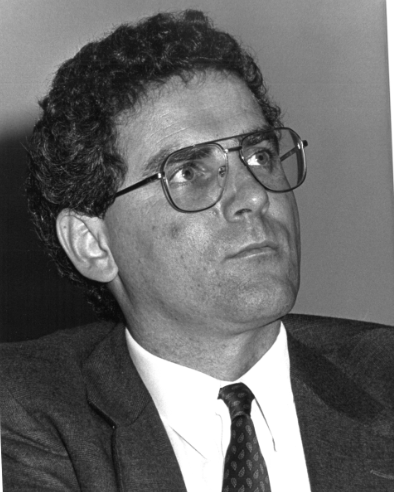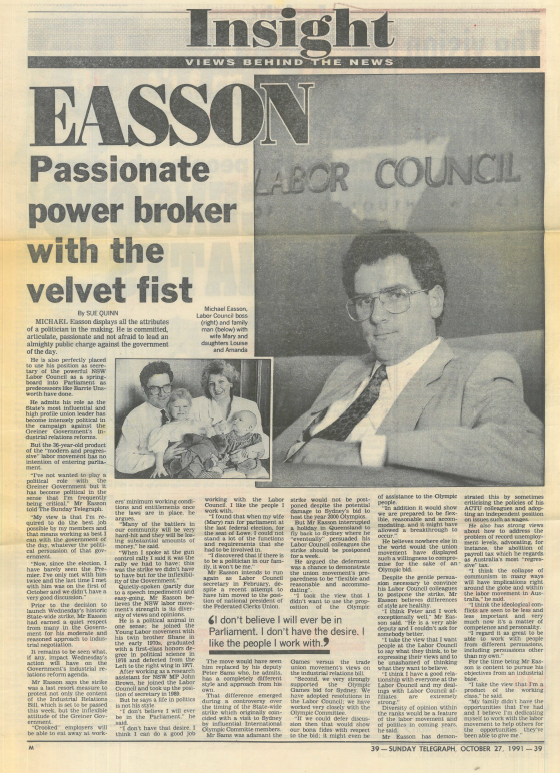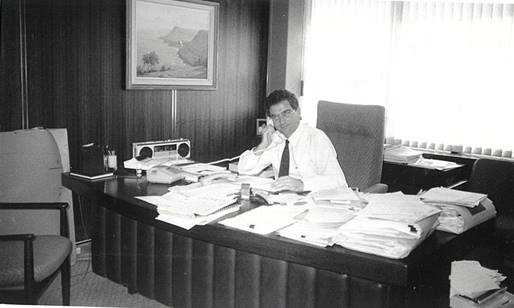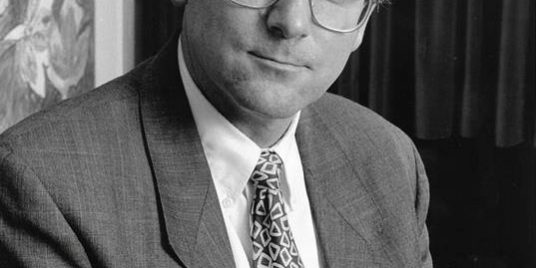This essay was written in September 2008 by a person previously in the employ of the Labor Council of NSW who intended to submit for publication. But owing to holding appointment to a senior role in public service decided to avoid any hint of political partisanship and therefore to refrain from publication. The article was sent without notice, after it was written, and on the condition of anonymity.
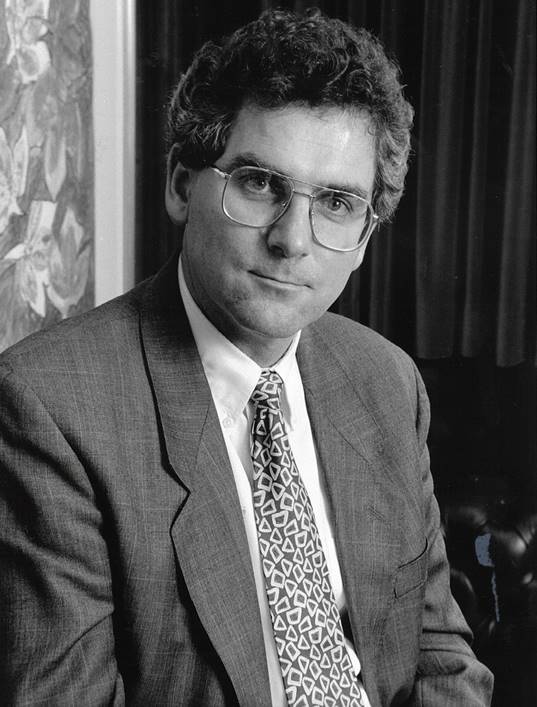
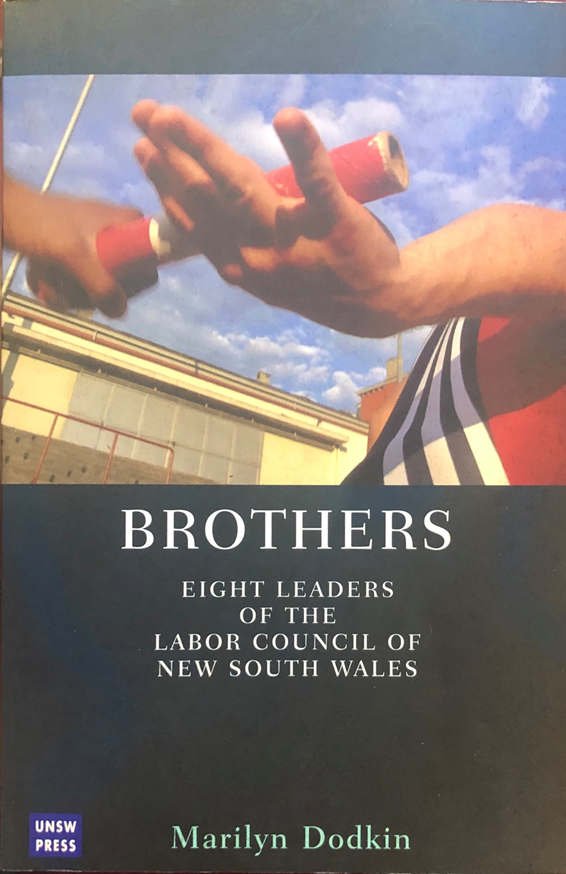
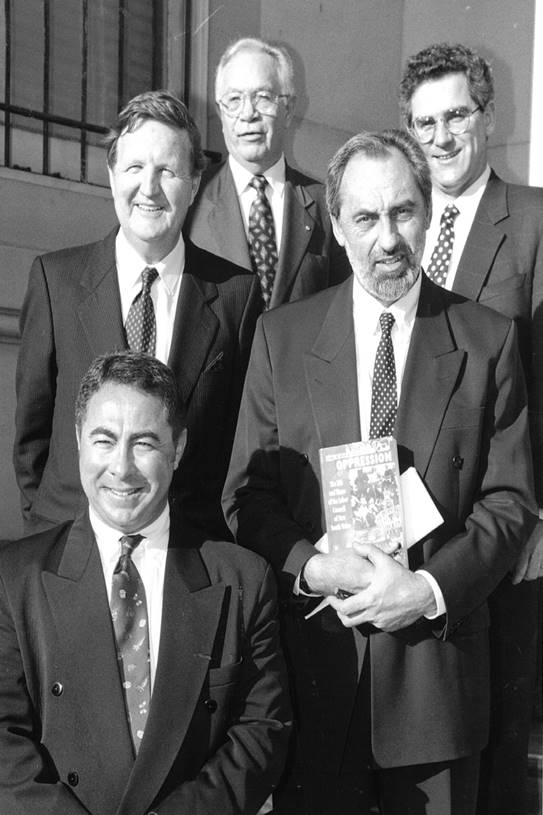
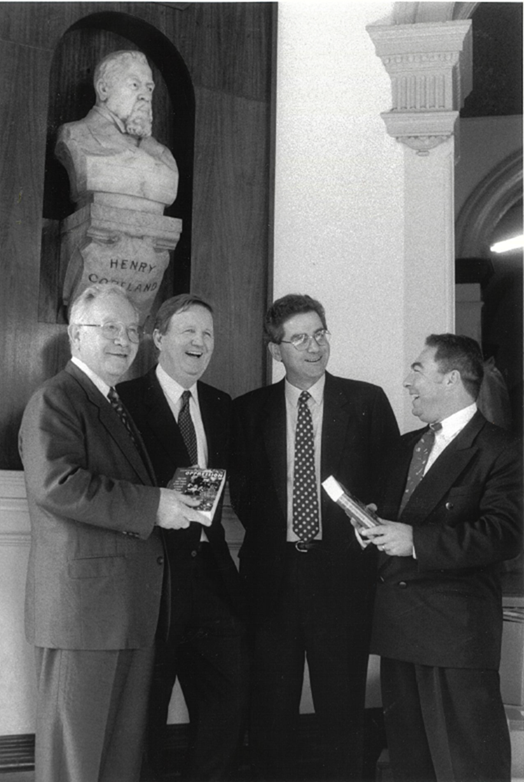
It is timely to revisit Michael Easson’s term as secretary of the Labor Council of New South Wales. Easson was the subject of criticism in some quarters during his period as secretary and criticisms have been aired subsequently.1 Easson’s style, role as secretary and political effectiveness need, however, to be seen in their own context – having regard to the exigencies of the time.
The first observation to be made is that Easson was the first secretary of the Labor Council who, in then recent history, had to meet the problems presented in, as leader of the State labour movement, dealing with a non-Labor government in New South Wales. Not only was Easson faced with a non-Labor government, the then newly-elected Liberal/National coalition under the leadership of the Hon. N. Greiner MLA (and subsequently the Hon. J. Fahey MLA) adopted an approach which was designed to diminish, or which would have had the practical effect of diminishing, the role of unions – albeit that such an approach had not been an explicit part of the Coalition’s pre-election platform.
One of the first legislative steps taken by the Greiner government was a foretaste of what was to come. The government moved quickly to introduce the Essential Services Act 1988. At the time it was understood that a motivating factor in quickly introducing that statute was so unions effectively would be neutered as the rest of the industrial relations legislative programme was unfurled. Importantly, given what was to come later, some legislative changes were brought about to the Essential Services Act by way of Labor Council-proposed amendments that addressed at least some of the perceived legislative excesses. Those changes were the result of partly successful lobbying of the members of the cross-benches in the Legislative Council. At the time, the cross-benches comprised the Australian Democrats Members of the Legislative Council (MLCs), the Hon. Elisabeth Kirkby MLC, and the Hon.Richard Jones MLC, and the Call to Australia Party, the Hon. Rev. F. Nile MLC, the Hon E. Nile MLC, and the Hon. M. Bignold MLC. Amendments were forced on the government in the Legislative Council as a result of the Labor Council’s lobbying. Political lobbying of a style undertaken by the Labor Council with Easson as secretary had not been undertaken before by the Labor Council, or by other State-based or national union bodies. Shortly stated, in the late-1980s and early-1990s, it was then still a comparatively recent phenomenon for minor parties and independents to hold the balance of power in the New South Wales and federal bicameral parliaments. The lobbying by the Labor Council of the newly powerful cross-benchers was a role brought about by the demands of changed times – and, as is outlined later in this paper, the lobbying ultimately delivered successes in protecting the interests of the Labor Council and its affiliated unions’ members.
During the early stages of Easson’s secretaryship, the Greiner government commissioned two major inquiries for the purpose of shepherding-in legislative change. Professor John Niland was commissioned to undertake an inquiry into industrial relations and subsequently released a two-volume green paper titled Transforming Industrial Relations in New South Wales. A much lesser-known inquiry was also commissioned around that time concerning union finance-related matters. That report was usually referred to as the “Meagher/Heyden Report”, after its two barrister (later judge) authors Roddy Meagher QC and Dyson Heydon QC.
Niland had been one of the most consistent advocates in academic circles for a move away from a centralised system of conciliation and arbitration, whereas most industrial interests in New South Wales were comparatively content with the then industrial framework. Although some submissions to the Niland inquiry sought broad-reaching change, the overall tenor of the mainstream submissions advocated changes not that far removed from federal “Hancock”-style2 and Queensland “Hanger”-style3 approaches to changes to industrial relations in New South Wales. That is, the submissions to the Niland inquiry made by most mainstream industrial interests did not make calls for major structural or legislative change. Industrial relations practitioners, instead, were presented with Niland’s recommendations for a sweeping legislative and structural overhaul. The proposals flowing from the Niland inquiry recommended numerous changes designed to decentralise industrial relations in favour of a strong enterprise focus; to diminish the role of unions (and employer organisations); to “dis-establish” the former Industrial Commission of New South Wales, and otherwise to diminish its future role and influence; to establish a new Industrial Court, concerned with the application of “black letter” law; to introduce a USA-style “interests/rights” dichotomy; and to introduce a number of changes generally having the effect of constraining unions in a range of industrial/political activities. The Niland recommendations also placed a strong emphasis on the integration of anti-discrimination and EEO themes into industrial relations laws, which was somewhat ground-breaking and well-overdue at that time in New South Wales. For its part, the Meagher/Heydon Report proposed changes which were akin to treating union members as minority shareholders of public companies, and union officials as company directors, and recommended “oppression”-type provisions and financial accounting measures borrowed largely from corporations’ laws.
Although the Niland recommendations were antithetical to many issues close to traditional union interests, there was, nonetheless, a strong semblance of balancing of competing industrial interests in his proposals. That overall balance did not, however, see legislative form when the government introduced the Industrial Relations Bill 1990. The legislation was promoted by the government as designed to promote “greater flexibility” in the workplace; however, it was regarded, by most unions and academics at least, as having a transparently anti-union and anti-Commission bias.
It does not assist when examining history to use the language of hyperbole, but the changes to industrial relations looming during Easson’s secretaryship, quite simply, were unprecedented in New South Wales. There had been a stable structural and legislative framework in New South Wales’ industrial relations for the better part of a century and, to that time, governments were not perceived as attempting overtly to undermine the role of unions through legislation in the way adopted by the Liberal/National coalition in the late-1980s and early-1990s. It was, however, a time of change in industrial relations internationally: Margaret Thatcher’s 1980s had forever changed British industrial relations; and, more locally, New Zealand was undergoing significant industrial relations reforms which were delivering what, at the time, seemed to be substantial economic benefits. Greiner and Fahey themselves did not appear to be overtly personally hostile in their approach to unions, but the general legislative proposals and policy approaches adopted by the Coalition, nonetheless, were broadly antithetical to the pivotal role that unions and the Commission then occupied. There was real concern at the time among unions that New South Wales was being turned into a “New Right” industrial experiment for the deregulatory approach then being promoted by organisations such as the Business Council of Australia. (Some aspects of the changes which seemed so controversial at the time now feature in industrial statutes across Australia and, with the passage of time, appear industrially unremarkable. Moreover, it cannot go unremarked that, even in the late-1980s, there was support among some Labor Council officers and affiliated unions for adopting a greater enterprise focus and having a greater emphasis on collective bargaining – particularly for strongly unionised workplaces.)
There were different views among unions as to how best to respond to the mammoth Industrial Relations Bill 1990. Many union leaders strongly were of the view that the only appropriate response was one of outright rejection of the industrial relations legislation, coupled with a campaign of industrial action; but Easson embarked on a different approach. Acutely aware there simply was not strong enough opinion (among the public, media and cross-benchers) that the government’s industrial changes were so flawed as to be rejected outright, Easson adopted the difficult task of persuading affiliated unions that seeking modification of the legislation rather than seeking outright rejection, was the course most likely to yield practical, beneficial outcomes. Some decried this approach as a Labor Council “sell-out”; it was, however, a politically astute approach to adopt, given the prevailing environment, and an approach which was, with the benefit of hindsight and given the outcomes, arguably the best approach for the Labor Council. It would have assisted the government in seeking to enact its legislative reforms to be able to portray New South Wales as populated by militant and unruly unions sorely in need of sweeping legislative controls. Easson has been the subject of criticism that he was too accommodating of the government. In truth, the strategies Easson developed to combat the government’s intentions were, however, multi-faceted and sophisticated; and they did not give the government the pretext wanted – needed – to persuade wavering cross-benchers to pass the full range of legislation that would have adversely affected unions. In some ways, the approach adopted by Easson may be seen as a precursor to the effective “Your Rights at Work” campaign against the Howard government’s Work Choices legislation.
Easson deferred to the wishes of some unions by coordinating through his officers the traditional, in some ways industrially predictable, responses involving stoppages and disputation. The most notable manifestation of the Labor’s Council’s involvement in this respect was on 23 October 1991 the “Day of Outrage”, a state-wide strike accompanied by metropolitan and regional rallies.4 This was the first such strike in New South Wales since 1917 and, of itself, should neuter criticism that Easson’s Labor Council adopted a “soft” response to the government. Although union membership numbers were at historically low levels, the rallies in Sydney and in regional centres were attended by decent-sized numbers and the day was an industrially symbolic event. Ultimately, however, the Day of Outrage was of no real suasion in terms of changing the government’s legislative agenda; in some senses, it gave the government some leverage for adopting a “hard line” response.5
What proved more important in real, as opposed to symbolic, terms was the way in which Easson went about corralling opposition to the legislation and otherwise raising broad community concern about the proposed industrial relations changes. Naturally enough, most in the union movement needed no persuading in opposing the changes. But Easson also conferred with registered employers’ organisations and major employers, and successfully highlighted concerns employers might have about the practical operation of the legislation. Many employer interests were, quietly at least, generally content with the existing industrial framework and had no wish for significant change; a number of major employers said as much to the government. Easson contacted academics and journalists to encourage them to articulate in print and in other media concerns about the changes. Around this time, Easson established a labour-minded “think-tank”, the Lloyd Ross Forum, to ventilate a perspective different from that being promoted by, for instance, the industrially conservative H.R. Nicholls Society. He prevailed upon a wide range of people to contribute to the written debate, including the then President of the Industrial Commission, the Hon. W.K. Fisher AO, who contributed an article in a Lloyd Ross Forum publication.6 Easson authored articles himself, aware that the industrial relations debate was being run – and hopefully would be won – on various levels.7 Easson ran an expensive advertising campaign in newsprint and on radio, which spilled-over into talk-back radio and opinion pieces; generally media-savvy, Easson personally cultivated the journalists who wrote such pieces and their editors. Easson rallied support from organisations such as the Australian Council of Social Services, by highlighting the effect the changes would have on those who were already socially and industrially disadvantaged. Easson similarly contacted churches and successfully prompted churches to voice concerns about the legislation. Easson even invoked the Pope, by arguing that the legislation was antithetical to a papal encyclical concerning social justice. In short, Easson worked every available angle – and then some – against the government’s proposed changes.
Easson faced an industrial and political environment different from that experienced by all comparatively recent Labor Council secretaries, and a criticism levelled against Easson was that he was not as closely involved as other secretaries in the ALP hierarchy. It cannot be said that the interests of the union movement and the ALP necessarily coincide; the differences between unions and ALP governments over workers’ compensation are visceral examples in that respect. While it may have been generally beneficial, however, for Labor Council secretaries to have high-profile offices and involvement with the ALP at times when the ALP was in government, such a role was generally contra-indicated during the Greiner and Fahey administrations. It would not have assisted in lobbying members of the cross-benches in the Legislative Council for the secretary of the Labor Council and the ALP to be effectively indistinguishable. In the case of Easson’s secretaryship there was a clear political imperative for some greater “product differentiation” between the Labor Council and the ALP, so that the respective organisations and their interests could not be portrayed by the Coalition as “one and the same” or self-serving, particularly in relation to sensitive financing issues. Union funding of political causes and parties is a traditional irritant to politically conservative interests, and such issues were being reviewed by the government when Easson was secretary, e.g., the Meagher/Heydon Report recommended changes which would have allowed individual members to take court action to seek to restrain a union from giving funds to, say, the ALP or for some political cause.
Easson built strong lines of communication with the members of the cross-benches in the Legislative Council and, by all accounts, was personally well-regarded by them. Easson effectively put himself and the staff of the Labor Council at the disposal of the parliamentarians, day and night, in the event they wanted any questions answered or information provided. The lobbying was personally customised by Easson and spearheaded by him; the day-to-day lobbying and negotiating was cross-factional, being conducted by more junior Labor Council officers – often in the company of officers of left-wing unions, particularly Daniel Reiss then of the Building Workers’ Industrial Union. Apart from the broad lobbying campaigns, Easson developed ways of individual lobbying of members which itself was finely focused. For instance, the former actor, Elisabeth Kirkby, was lobbied by Easson in the company of representatives from Actors Equity and the socially conservative members of the Call to Australia Party were lobbied by Easson in the company of prominent, Church-minded, conservative unionists. Members of lobbying delegations were even instructed by Easson not to smoke cigarettes while at Parliament House (at a time when smoking was still permitted in the building), for fear of alienating the vote of the vehemently anti-tobacco Democrat MLC Richard Jones. As a follow-up to parliamentary votes, Easson urged affiliated unions and their members to write letters of thanks to the parliamentarians, to profile them in articles in their union journals – and to make sure that the parliamentarians received copies of the articles.
The Industrial Relations Bill 1990 was, at the time, the longest legislation that had been introduced into the New South Wales Parliament. The government used its numbers to gag debate in the Legislative Assembly, but by the time the Bill had finished in the Legislative Council, it was the most heavily amended Bill in the history of the Parliament with over 300 amendments.[8] The amendments prepared by the Labor Council were moved and articulated on the floor of the Parliament principally by the then shadow Minister for Industrial Relations, the Hon. J.W. Shaw QC MLC.
It may be noted that Easson’s legislative strategy was not one which was merely reactive to the government. For instance, Easson, in conjunction with the Democrats and with the agreement of the ALP, arranged amendments to the Industrial Relations Bill which represented the first legislative attempt to grant paternity leave and adoption leave rights in Australia, following upon the test case decision of the Australian Industrial Relations Commission in the Parental Leave Case (1990) 36 IR I. The Minister for Industrial Relations, John Fahey, who was a member of the Legislative Assembly, made the rare step of taking to the floor in the Legislative Council to personally debate the legislation and the proposed amendments. There were so many amendments that they were moved, several at a time, en globo. Despite the effective and well-informed debate by Fahey on the changes, important divisions were lost by the government on the floor of the Legislative Council. The amendments were successful in key strategic areas; the Bill was gutted. The strategy developed and implemented by Easson in response to the Coalition’s proposed legislative changes had proved to be effective.
Some piecemeal industrial changes subsequently were introduced in a series of bills colloquially referred to as the “bite size chunk bills”, with varying measures of success. The bills were diluted versions of some of the central changes that the government had unsuccessfully tried to enact.
The campaign against the legislative changes over which Easson had presided was so successful that the government, frustrated by comment that it lacked electoral mandate for the changes and by the inability to enact the industrial relations changes, called an early election to seek a mandate on industrial relations reforms. The government was re-elected. When the legislation was reintroduced on 28 August 1991 as the Industrial Relations Bill 1991, after an election called by the government on the specific basis it could not have its industrial relations changes enacted, the proposed industrial changes were modified in some significant respects. The government was aware that, even after calling an election based on seeking a mandate for its industrial relations policies, it would not be able to push all its legislative programme through the Legislative Council. What was left of the government’s initial proposals became the Industrial Relations Act 1991. This too was complicated in its attempted comprehensiveness: “The Bill was the largest piece of legislation ever introduced into [the] NSW parliament, being some 333 pages and 750 clauses.”9 That statute was widely regarded as having been both cumbersome and ineffective, and there was not much real or sustained enthusiasm among even the employer ranks for the changes introduced by the government. The industrial parties endeavoured to skirt-around the new legislation and conduct industrial affairs much as before – witness, for example, the emergence of “splinter awards” to avoid the legislative difficulties in varying awards during their nominal term. Indeed, it was not uncommon during the Easson years for the Crown to initiate appeals in the Commission about approaches that had been developed cooperatively by the Labor Council and employer interests.
On any fair analysis of it, Easson had demonstrable successes in the strategies he oversaw to attack a legislative agenda which was regarded as antithetical to unions, workers, and the Commission. The media reported the eventual form of the legislation as involving qualified wins for unions and, with the passage of time, that view still holds.
Apart from opposing changes to industrial laws, Easson’s Labor Council was also heavily involved in opposing the government’s proposed changes to WorkCover and TransCover. The workers’ compensation and insurance changes were regarded as highly contentious and were opposed by unions and the legal profession. The lobbying coordinated by Easson saw the Labor Council, the Law Society and the Bar Association in an unusual partnership jointly prevailing upon the cross-benchers to reject the government’s proposed changes – although, it must be said, with entirely different purposes. Once again, Easson coordinated a multi-faceted campaign opposing the changes. A media campaign was mounted, and the Labor Council organised a major rally outside Parliament; and, once again, Easson personally tailored the lobbying of the cross-benchers. For instance, when it came to light that some MLCs were the parents of police officers, Easson arranged for the Police Association to form part of the lobbying delegations and used examples of what may occur to police officers injured on duty. The MLCs were personally introduced to workers who had suffered catastrophic, work-related injuries and showed the parsimonious payments they would receive under the ‘Table of Maims’ – which set a scale of fixed money amount for specified classes of injuries. At various points, Easson persuaded the ALP to organise a filibuster in the Legislative Council for the tactical advantage of buying more time, so that the government’s intention with proposed legislation could be frustrated. In August 1989, for example, on workers compensation reform, the ensuing debate resulted in the longest unbroken sitting of the Legislative Council, spreading to 27 hours. The Labor MLC Mike Egan quipped: “To my knowledge the only other institution that keeps the hours this House has kept over the past 24 hours is a brothel. …this House – the oldest legislative Chamber in this nation – is in danger of becoming a house of ill repute.”10 Although passed by the Legislative Assembly in April 1991, the Workers Compensation (Benefits) Amendment Act 1991 did not pass through all stages by the end of the sitting term. The government was, however, resolute that the parliament would not rise until its worker’ compensation changes were forced through the Legislative Council. Sleep-deprived and weary, the cross-benchers were persuaded by the government that the costs to the State of the existing workers’ compensation arrangements would leave the New South Wales in penury. With various legislative initiatives over several years, most of the government’s wishes were eventually implemented but not, it must be observed, without the vehement opposition from the Labor Council.
Easson encouraged the exchange of ideas and policy development among the employees and officers of the Labor Council and would enjoy playing devil’s advocate or putting people to proof as to why he should be persuaded to one view over another. In that context, it is troubling to see the assertion in Brothers that a Labor Council employee was made a “sacrificial lamb” for expressing views that differed from the prevailing ACTU line. Similarly erroneous views still seem to have currency as recently as 2008.11 Easson publicly supported the right of Labor Council staff to hold and express their own views on matters of policy, including the views espoused in a controversial policy discussion paper authored by two officers who were then employed by the Labor Council, namely, Mark Duffy and Michael Costa. The views expressed by Costa and Duffy were not of concern to Easson: the paper had been the subject of strident discussions when it had been presented at an in-house conference of Labor Council staff and officers. When the document was printed in the newspapers – resulting in criticism of Costa and Duffy from a range of high-level unionists and Labor politicians – Easson rejected outright the calls made to dismiss the two officers. While Easson did not associate himself or the Labor Council with the ideas expressed by Costa and Duffy in their discussion paper, Easson defended their prerogative to hold views different from the then dominant ACTU orthodoxy and laughed off concerns as to their suitability to continue working at the Labor Council. It was, however, a matter of understandable concern to Easson that an internal policy discussion paper had been leaked to a newspaper, particularly given the political sensitivity of some matters canvassed in the paper. A committee of senior members of the Labor Council’s Executive was convened by Easson to investigate how the document came to be printed in the newspapers. It was later reported in the media that Duffy had given a copy of the paper to a trusted colleague; the dismissal was concerned with giving an internal document to a person outside the Labor Council, and withholding that fact from Easson, not with its contents.
Much has been made of the fact that Easson is a man with strong intellectual leanings who, while secretary, cultivated interests beyond the Labor Council itself – sometimes in tones suggesting that this was somehow a bad thing. Ray Markey, in his history of the Labor Council of NSW said of Easson:
[He] was willing to consult with factional opponents to a degree which sometimes unnerved his own factional supporters. Yet, as with his predecessors, Easson possessed a toughness which did not allow him to be easily taken advantage of, despite his relatively softly spoken style, and the almost ‘bookish’ appearance lent by his glasses and thick dark hair.12
Easson openly encouraged the development of new ideas and strategies among officers at the Labor Council, and among affiliated unions. Easson earned a considerable degree of personal loyalty from many of the people who worked with him as staff and officers at the Labor Council because of his willingness to listen to them and his concern about trying to do the right thing, coupled with his inherent personal decency. As part of Easson’s “hands-off” managerial style, decisions typically were left to the individual judgment of the officers in question. Easson once said, memorably, that if you could not be trusted to make an appropriate decision on your own, then you should not be working at Labor Council in the first place.
Other Labor Council secretaries have received praise for broadening the right wing/left wing union and ALP political base of the staff and officers. For his part, Easson encouraged the involvement in Labor Council-related activities of those whom he regarded as talented, largely irrespective of their political affiliation within the left/right political spectrum. He took the issue of broadening the Labor Council’s own staff base much further than any secretary before him by employing a person who was closely connected with the Australian Democrats, namely Armon Hicks. Easson also involved Labor Council officers and employees in issues which went beyond the strictly industrial, but which were entirely compatible with precepts of general social justice. Easson was particularly strongly committed to the interests of political prisoners and refugees and was well-known for circulating among staff (and sometimes to affiliates) human rights articles from local and international journals. Consistent with the broad approach taken by Easson to the extra-industrial role of the Labor Council, Easson, with the able coordination skills of his executive assistant, Tom Forrest, organised a rally in the forecourt of the Sydney Opera House to welcome Nelson Mandela to Australia. The rally was attended by crowds estimated at 100,000 and was rightly regarded as a marked success.
Easson’s period as secretary ultimately had a troubled conclusion, involving financial difficulties, staff retrenchments and a failed tilt for political office – being matters which are not addressed in this paper as they have been well canvassed elsewhere. The assessment of Easson’s secretaryship, in what I would contend is an unbalanced way, has focused on that conclusion rather than on what was achieved during the whole time he held office. Shortly stated, Easson’s achievements as Labor Council secretary, in an environment more politically hostile than that encountered by the secretaries who preceded him, have not been properly acknowledged. This paper may provide a different perspective. As another former Labor Council secretary, John Ducker, noted when asked about his judgment on Easson’s term: “I think it is true that the circumstances of the time that people are in have an enormous effect. You’ve got to be relevant, you’ve got to be tuned in, so each of these periods mark a distinct contrast.”13
Notes:
1. Dodkin, M., Brothers – Eight Leaders of the Labor Council of NSW, UNSW Press, Kensington, 2001.
2. A reference to the Hawke Labor government’s appointment in 1983 of a Committee of Review of Australian Industrial Relations chaired by Professor Keith Hancock which reported in 1985. Hancock concluded that the systems which had served Australia for nearly eight decades were fundamentally sound though saw merit in moderate changes, including the development of arrangements to allow parties to ‘opt-out’ of awards in some circumstances.
3. A reference to a Committee of Inquiry review of industrial relations law and practice in Queensland led by Ian Hanger QC which reported in November 1988.
4. See articles in the Sydney Morning Herald at the time, e.g., ‘It’s a State of Chaos’, Sydney Morning Herald, 23 October 1991 and all issues of the paper that week.
5. Cf. ‘Greiner: I Won’t Give In’, Sydney Morning Herald, 24 October 1991, p. 1; Lansbury, Russell D., ‘The Harder Edge of Industrial Relations: Legislation That Provoked a General Strike in New South Wales on 23 October 1991’, Directions in Government, Vol. 5, No.10, November 1991, pp. 16-17.
6. Fisher, W.K., ‘The Green Paper: A failure in Consultation?’, in Transforming Industrial Relations, Pluto Press, 1990, pp. 109-116.
7. See, for example, ‘Industrial Relations, the Grinning Mirror, and Inflation’, in Transforming Industrial Relations, Pluto Press, 1990, pp. 53-74.
8. Griffith, Gareth, ‘The New South Wales Legislative Council: An Analysis of Its Contemporary Performance as a House of Review’, Australasian Parliamentary Review, Vol. 17, No. 1, Autumn 2002, p. 59.
9. Dawson, Neale, ‘Industrial Reform in NSW. Economics Before Workers’ Rights?’, Legal Service Bulletin, Vol. 16, No. 6, December 1991, pp. 284-5.
10. NSW Legislative Council, Hansard, 2 August 1989, p. 9118.
11. See article by Alex Mitchell in [the website] crikey.com 7 May 2008.
12. Ray Markey, In Case of Oppression. The Life and Times of the Labor Council of New South Wales, Pluto Press and the Lloyd Ross Forum, Leichhardt [NSW, Australia], 1994, p. 416.
13. Dodkin at 196.
Postscript (2020)
I received this manuscript “out of the blue” from someone who used to work closely with me. It was gratifying to see a positive assessment.
With this revised michaeleasson.com website going up, this prompts me to account for my time in the Labor Council of NSW (renamed in 2004 as Unions NSW), the circumstances that led to my election as assistant secretary, then secretary, and the five years I spent in that role. An earlier prompt came in June 2019 when I did an interview with Pat Garcia, the then NSW ALP Assistant Secretary, who told me he wanted to interview me for his PhD as he had me down as the “technocratic” Secretary. “Ahuh”, I thought. I am not sure what he meant by the term, and I am not sure if he did either.
No doubt in what follows in this Postscript, blind spots, defensive embellishment, and self-aggrandisement will be readily apparent.
When I became assistant secretary of the Labor Council of NSW in 1984, aged 29, it was completely by surprise. The pea for the job was shot out the door. A rethink occurred on what and who was needed. Chris McArdle was the Labor Council organiser groomed for the role. He was a university-educated former Australian Workers’ Union (AWU) national industrial officer. Feedback on his performance at mass meetings of unionists, on delegations to employers and NSW government ministers, on various industrial matters, was mixed. Sometimes his wise-cracking personality put off people. I thought he was industrially astute, but Unsworth who was closer to the “action” than I was at the time decided that the “supercilious bastard” had to go.
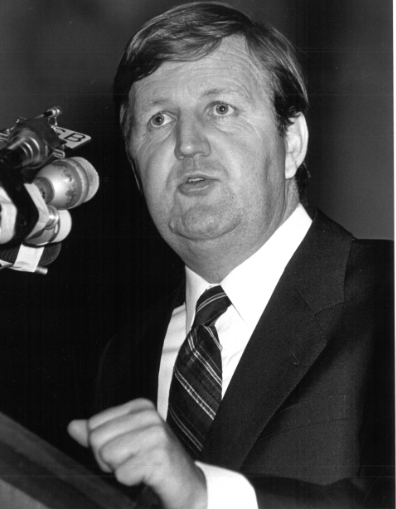
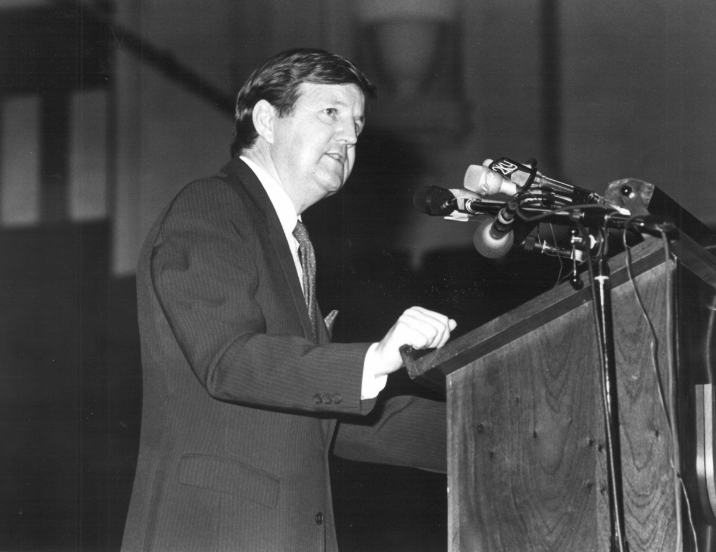
That gave me my chance, not that I had a clue that I was under any kind of consideration for the job. I had never lobbied against McArdle. I had not sought promotion. I got on well with him. (An exception to my assessment arose from the shock of reading his 1982 draft report on a union delegation to China, which he led. I had to completely rewrite the document to qualify, deny, and tone down various passages uncritical of the Chinese regime. His report was later published as a pamphlet.)
Unsworth one day walked into my office and announced his decision. More or less, I was told: “He’s going and you can be our candidate. Are you interested?” That was a shock. Naturally, the assistant secretary, John MacBean, Unsworth’s successor-in-waiting, had to decide if he wanted me on the ticket. He thought about other options. (Years later I discovered that John Grayson, then an industrial officer with the Public Service Senior Officers’ Association, was another person considered. He would have made a good appointment.) MacBean settled who should be his assistant secretary. An election of all the delegates to the Labor Council needed to be held at the February 1984 annual general meeting. I was dispatched to see the various union secretaries to canvass support. Unsworth and MacBean made introductions. A caucus of moderate unions unanimously endorsed me as the right-wing candidate. Overwhelmingly, this was because of affection for Unsworth and MacBean and trust in their judgement.
Some union leaders saw me as an ideological heir to Unsworth, others as a good complement to MacBean, and others as a hard-working youngster who was worth punting on. A few more thought I was an inexperienced greenhorn who was a gamble for the role. Those views sometimes overlapped. Certainly, I was “green” in day-to-day “industrial relations” experience. Would I grow into the job? The majority view was “yes”, which explains the wager.
Why was this happening? What prompted Unsworth to move out of a full-time role at the Labor Council? This had to do with NSW ALP politics.
Following a hotly contested decision by the 1979 NSW ALP conference to admit members of the NSW Legislative Council (MLCs) into the NSW parliamentary Labor caucus as full voting members, Unsworth had to decide on a career in full time politics or relinquishing his position as a MLC. That was because Premier Neville Wran insisted as part of the quid pro quo that after future NSW state elections, the MLCs needed to be full time; previously they were part-time.
Unsworth, elected as a part-time MLC at the 1978 NSW state election, was torn about what to do. In 1984 he faced re-election. He had to decide either to go full time in politics and resign from the Labor Council or not stand again. He loved the union movement. But he felt that the NSW government did not sufficiently appreciate its industrial base. Some conflicts between the government and the unions in health, transport and the electricity sector, for example, were avoidable or could have been managed better. He knew reforms were needed in many areas and he thought he could make vital contributions as a senior minister. He leapt to the plunge. (Years later, both of us unawares that a few weeks in June 1986 Premier Neville Wran would resign and Unsworth would be selected as the new NSW Premier, Barrie was frank about the choices made. He missed the camaraderie of the movement. “Here”, pointing around the NSW parliament building:
you are on your own. Everyone in their own forts, hoping you fall over. There’s a lack of loyalty, of comradeship. You don’t talk much with your colleagues. At the Labor Council we had more in common with the left than most people here. You felt part of a movement. The politicians think of themselves.
That made me feel at the time even more of the view that full time elected politics required unusual temperament and stamina. I questioned whether that could ever be me — thinking later, that in comparison, Mary Easson was a natural for politics.)
In the nearly six years prior to my election as assistant secretary in 1984, I worked at the Labor Council as Education and Publicity Officer, but mainly as Barrie Unsworth’s executive assistant/gofer/researcher on all things. I had no idea where I might go to next, other than a view that hopefully it would always be with the labour movement. I had given up interest in ever becoming an academic. A reason for this commitment was that the Labor Council had been kind to me.
In 1981, I was selected to go to the then 13-week Harvard Trade Union Program at the Harvard Business School, and then a US Leader Grant to visit unions and conferences on US industrial relations, industry organisation and Democratic politics, and then to the United Kingdom to spend 3 weeks with the Electrical, Electronic, Telecommunications and Plumbing Union (EETPU), then led by Frank Chapple (1921-2004), the heroic ex-communist turned right-wing UK Labour supporter who wrested control of the union off the communists in the early 1960s.
A significant investment in my development was made. I owed the movement big time. In 1994 at a function to mark my time at the Labor Council I offered a toast to the paranoia of the left at that time. Perhaps if no Harvard, no subsequent role as an elected Council Officer.
Two asides: on selection to Harvard in 1981 and on how I saw my role. First, my Harvard selection was a fluke. Judith Walker (1938-2001), NSW Secretary of the Australian Insurance Employees Association (later merged into the Finance Sector Union), was picked. Her national secretary, however, forbade her to go; he alleged that a course taught on one of the most liberal campuses in the United States was a CIA-front. In her place I went. Barrie Unsworth walked into my office that July and asked what I was doing in September. I flew out – my first overseas trip – after the 1981 ACTU Congress that month. (Judith became a Vice President of the Labor Council in 1982 and a full-time MLC in 1984, retiring from politics in 1995. On her parliamentary web page, in her list of recreations she included “classical music, reading and listening to peers with a sense of history.” She was tough, funny, and never forgot where she came from.)
Second, I saw my role at the Labor Council as a vocation. Others in the movement had similar perspectives. We thought we were making the world a better place and we had a responsibility to serve a higher cause. Some on the right in the Australian labour movement were religiously motivated in thinking that way.
On my return to Australia at the end of January 1982, I wanted to hone my skills in industrial relations and deepen my knowledge of industrial relations law. I enrolled in a Diploma of Labour Relations and the Law which was taught in the early evening at the Law School at the University of Sydney, then located on Phillip Street in the city. In first year (of a two-year period of part time study) I passed one subject with a HD but was refused permission to sit the exam for the other, as I physically had not been present for 60% of the classes. My absence mostly due to attending meetings after hours for the Labor Council. Unsworth had launched the “rubber chicken offensive”, urging that Labor Council officers and union leaders speak at community gatherings on why unions mattered. (“Rubber chicken” being the moniker for the typical meal served at such events.) I approached numerous Lions, Apex, Rotary, and other clubs with the offer of a guest speaker. More than half the time, as others were busy or had too little notice, I was the person to turn up. I was single (not marrying Mary until November 1984) and therefore freer than most.
I read the labor law lecture notes (others had copied theirs for me.) So, exam or no exam, from my studies and from the weekly Council meetings and other activities of the Labor Council, I generally was on top of most areas of NSW and Federal labour law. The related politics I knew from avid interest.
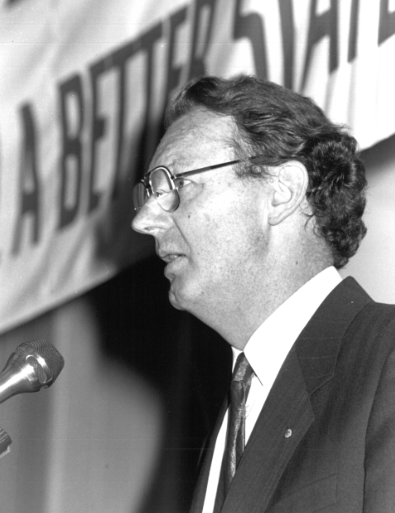
Quid Pro Quo
As earlier stated, my selection as the Labor Council officers’ choice for assistant secretary of the Labor Council of NSW was announced in late 1983 and there was overwhelming support (such was the regard for Unsworth by most of the right-wing union officials in NSW, rather than any particular merit of my own.) There was some surprise and anticipation by parts of the left that I might be vulnerable to dissenting right wingers upset at McArdle’s removal from contention. But that did not prove to be the case.
Of that moment in time, Meredith Burgmann wrote in a column on “Australian Trade Unionism in 1983”, Journal of Industrial Relations, Vol. 26, No. 1, March 1984, pp. 95-96:
In New South Wales, the Labor Council remained firmly in the hands of the right, but problems arose within its own ranks. With the removal of Barrie Unsworth to the state political arena, the obvious candidate for secretary was John MacBean. But who was to replace MacBean as assistant secretary became the burning issue, highlighting particular problems of the right wing of the New South Wales union movement. Over the past few years, the Labor Council has been recruiting as its full-time officials ‘bright young men’ with untested ability and little or no rank-and-file experience of trade unionism. Consequently, in this instance, a choice had to be made between a senior organiser who had not performed up to expectations and a more junior colleague who had no trade union experience at all. The inexperienced candidate was chosen and the senior organiser offered a post as State conciliation commissioner. Whether the loyal supporters of Unsworth and MacBean will accept an assistant secretary who they perceive as a ‘young student’ with no trade union background remains to be seen.
It was not fair to say I had no union experience; I had already six years in the Labor Council. In working part time during my university degree, I loaded and unloaded trucks at Ansett Freight Express and was a member of the Transport Workers’ Union. But it was true that I was not steeped in years of practical industrial relations. My age was against me. There was no use pretending what I was not.
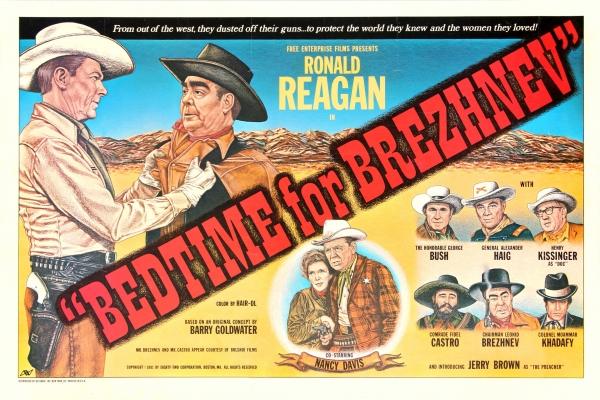
In February 1984 Stan Sharkey, NSW Assistant Secretary of the Building Workers’ Industrial Union (BWIU) ran against me, and I won with about 70% of the vote.
With the ALP, usually the Labor Council Assistant Secretary joined the NSW ALP Administrative Committee and took on a major role in the top leadership of the party. But I did not. At the end of 1983/early 1984, Stephen Loosley the General Secretary of the ALP, NSW Branch, wanted me to give up editing LaborLeader, the ALP right journal and to handover the running of the McKell Schools to whomsoever he appointed. Unsworth agreed. He thought “quid pro quo”. He counselled not to be greedy and take on too many roles. Let Loosley run the ALP, MacBean was President of the NSW ALP Branch (replacing Paul Keating in 1983) anyway; my role was to support MacBean. As assistant secretary of the Labor Council my loyalty was to the union movement, rather than the ALP. Make that choice, concentrate on that, was the message. In all the circumstances, this was the right advice.

I missed running the Schools, originally called Social Democrat Schools, which were started by Bob Carr in 1976, then moved to me to run from 1978-1984 after I replaced Bob at the Labor Council. The Schools blooded into the NSW ALP right the young and new activists, and involved lectures on party history, contemporary issues, economics, foreign policy, and media training. We typically met on a weekend at the Women’s College at the University of Sydney. Thirty years later, Chris Bowen MP told me that we first met at one of those weekends, when he was a senior high school student.
It was an excellent way to acculturate promising talent into a wider movement, enabling networking with like-minded souls. We discussed policy, including the challenges of economic and industrial relations reforms in the lead-up to and the early days of the Hawke government.
The Schools eventually reduced in number and turned into lectures on “campaigning”. Discussion and debate on policy issues diminished, eventually fading from view. (I suspect this is relevant to the decline of the NSW ALP right as a powerhouse of ideas. This, however, is a complicated topic best addressed separately – if at all, another time.)
Those developments I followed rather than with any active involvement.
As Assistant Secretary
As assistant secretary of the Labor Council of NSW, I convened meetings of the rail and transport unions, the maritime sector, the steel industry, sometimes the metal unions, the building trades, etc. Peter Sams, as the senior organiser, dealt with major matters before the Industrial Relations Commission of NSW and the federal tribunals. As did I from time to time. Familiarity with the procedures and personalities I needed to learn; but once that occurred it was not as daunting.
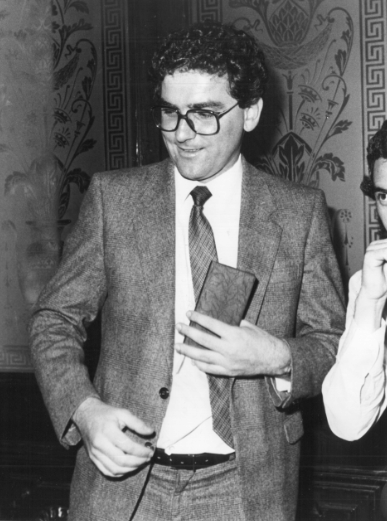
Notwithstanding factional allegiances and the “past” of officials at the Labor Council, we all tried to be fair, as objective as we could, in dealing with competing interests of unions, especially demarcation disputes (disputes over union coverage, where one or more unions competed for membership.) We were seen by nearly all the unions, Left, Right and independent, as reasonable.
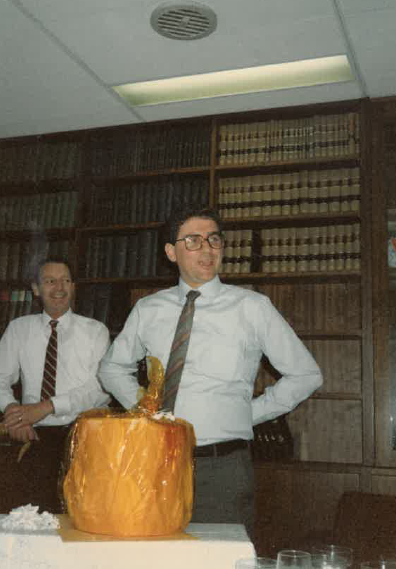
I respected the leadership of the old Building Workers’ Industrial Union (BWIU) – in particular, the NSW secretary of the union, Stan Sharkey. His somewhat cantankerous deputy, Don McDonald (1938-2018), was more difficult but sincere. (After Don McDonald died, I sent a message of sympathy, which was read at the memorial by his brother Tom McDonald. I said: “I always liked Don: tough, argumentative, sometimes hard to take, but a man of great honour, principled, a heart of gold: One of the great characters of our movement, one of the best of the old BWIU. Tremendous campaigner for schizophrenia research.”)
If you did a deal with one of whom we used to call the “ocker Stalinists” (the working class, pro-Moscow union leaders), it stuck. (Post-merger into what became the Construction, Forestry, Mining Employees Union, the CFMEU, the more recklessly militant from Victoria and Western Australia, eventually gained control of many of the state branches. That occurred post my time at Labor Council.)
Labor Council and the ACTU
With the ACTU, MacBean preferred that I minded the fort in Sydney, especially as nearly all the ACTU Executive meetings were in Melbourne. Each state was represented on the ACTU executive through their Labor Council or Trades and Labor Council. I was John’s alternate, from 1984/85. After John’s election in 1985 as senior vice president of the ACTU (which meant he held an ACTU executive position in his own right), John nominated Jim Walshe, secretary of the Australian Railways Union (ARU), NSW Branch, and a vice president of the Labor Council, to serve on the ACTU executive as the Labor Council representative from 1985-1989. I was Jim’s alternate. (Jim regarded Lloyd Ross, one of those retired unionists I most admired, as a sometime mentor and model of an innovative union leader. Though, like most of Ross’ allies in the ARU, he thought Ross stayed too long as secretary and saw his backing in 1969 of a communist as his successor as sadly odd.) I liked Jim as one of the best people I ever met in the movement. A twinkling eye, a sense of the absurd, and an Irish lilt immensely improves your chances of being listened to!
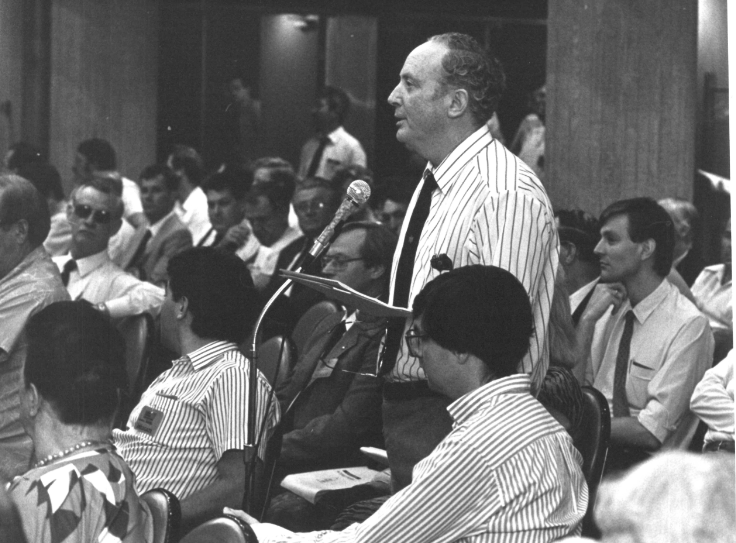
I observed from a distance those matters discussed at the then regular ACTU Executive meetings which met at least four times a year stretched over a full week.
That therefore left me as the acting secretary in Sydney, conducting the regular Thursday night weekly meetings of the Council which, most weeks, attracted 150-200 delegates from unions. I spoke at Labor Council meetings and grew in experience. Knowing I was a slightly serious character, John Whelan (1934-2015) from the Commercial Travellers Association, later merged into the National Union of Workers (NUW), recommended that I tell a joke at the beginning of each meeting. Everyone would then relax. Some good and bad jokes were told – how many times the laughter was with or at me I could not say. But at least they were laughing!
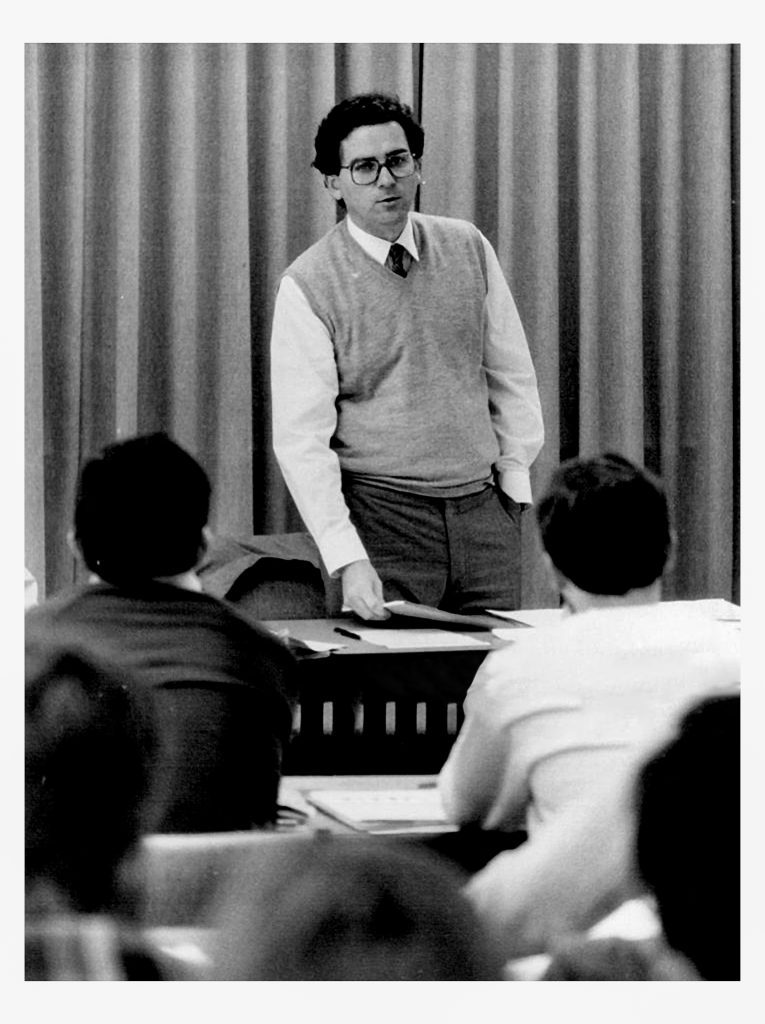
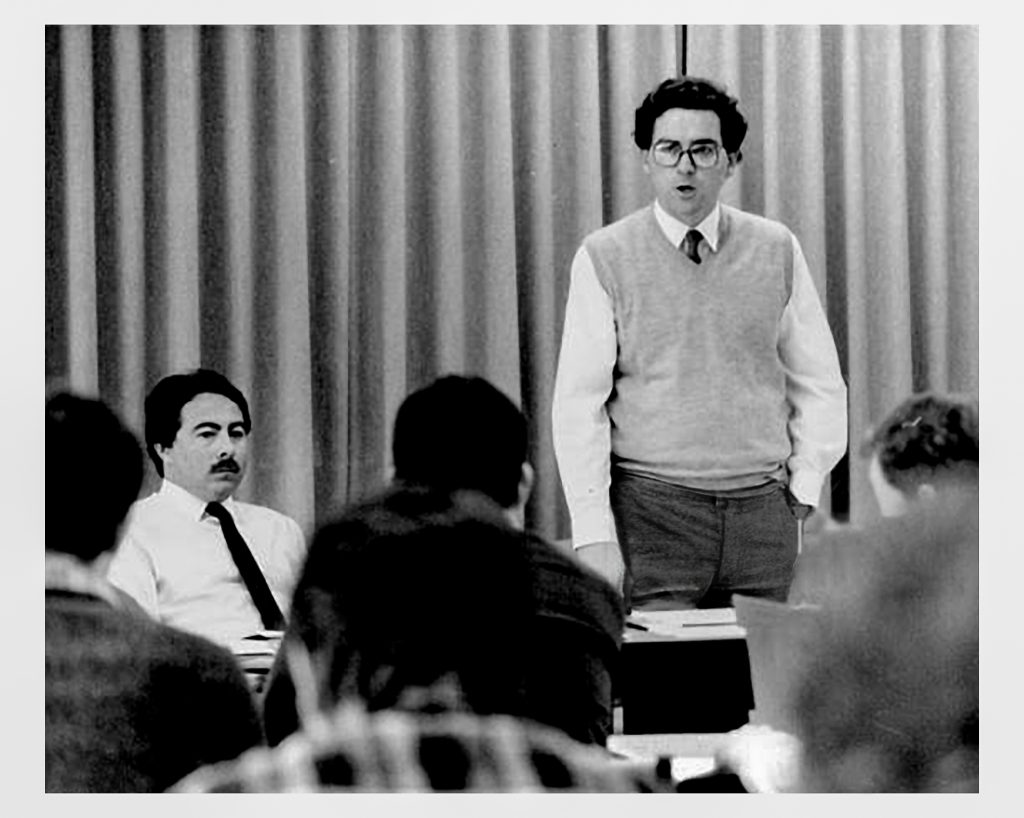
Several things I thought about were financial services and extending superannuation coverage and benefits in the private sector.
From 1984, I was a Labor Council representative on the Public Authorities Super Scheme, which in 1988 merged with State Super. The latter was once the largest superannuation fund in Australia. I learnt more on those boards than anywhere else. I thought the Labor Council should seek a role in the development of superannuation. At one time in the mid-1980s, I put to ACTU Assistant Secretary Gary Weaven (the ACTU officer primarily responsible for setting up the major industry superannuation schemes) that I could get the NSW Employers Federation, the Chamber of Manufactures of NSW, and ourselves to set up a NSW default scheme. “If you do that, you can have NSW,” he said. I am not sure Weaven could deliver, but that was his offer. In NSW, however at that time, there was a lack of appetite. I was told some unions wanted a pay raise for members rather than more in their “super” account. Phil Holt, the head of the Chamber of Manufactures, was enthusiastic. They owned an insurance company, Manufacturers Mutual, and were commercial. The head of the Employers Federation of NSW, Garry Bracks, on the other hand, was dismissive. “Michael, these people do not have a clue. The idea of handing money over to inexperienced union thugs is unthinkable. Make no mistake: by the end of the year, Weaven or one of his mates will be in jail.” He had a way of making definitive statements. He thought that the building industry super fund would end in tears. The “shock and awe” training of his mentor, Alan Jones (his immediate predecessor as head of the Employers Federation), was to the fore in making this wild claim. The early industry “super” funds were understandably paranoid about the potential for discrediting probity lapses and were mostly conservative in their evolution and investment strategies. Balancing boards with 50% employer representatives blocked or tempered the more stridently ideological positions.
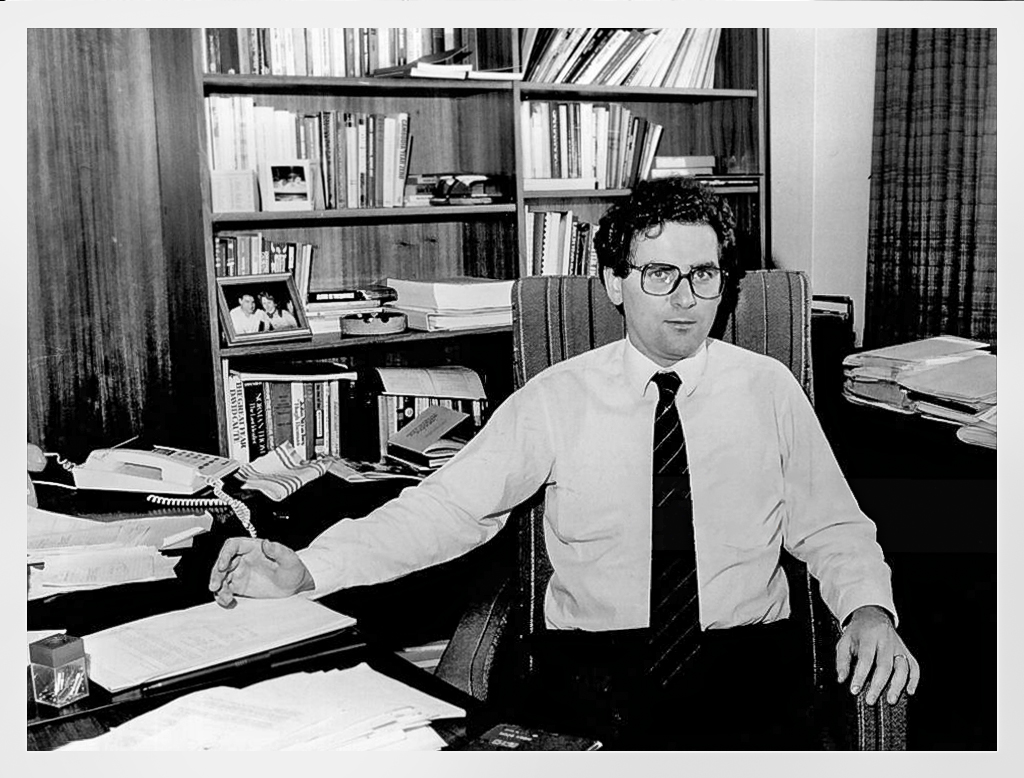
In any event, my idea of a NSW statewide scheme was stranded, eventually coming to fruition in emasculated form well after momentum was in the sails of the first industry funds. Good luck to them, I thought. In 1988 Brack said he would agree to a default scheme, which we agreed with the Chamber (after brand marketing advice) would be called Asset Super, that would only take 3% contributions, the then minimum award standard, but not more (which therefore in my time at the Council excluded award or enterprise agreements with higher contributions, thereby stunting the growth of Asset Super. In 2012 with $1.6Billion under management, Asset merged with the larger industry fund Care Super.)
Tensions with the ACTU
There were tensions between John MacBean and the ACTU leadership on union amalgamation and industry policy, and even with Paul Keating. When Barrie Unsworth was defeated as Premier of NSW in March 1988, the Greiner government ministers foamed about industrial relations reforms, privatisations, sackings of public servants, reductions in employment in key authorities, such as rail and electricity, removal of union-related directors from NSW government authorities. As President of the NSW Branch of the ALP (having succeeded Paul Keating in 1983) and as Secretary of the Labor Council of NSW, MacBean was criticised as “too political” by the new government.
With the ACTU’s dominance in setting the direction of union strategy, even sometimes directing traffic to and from the Treasurer’s office, MacBean’s previously close relationship with Keating frayed. I wrote for John a detailed analysis of the ACTU union amalgamations/rationalisation strategy and its long-term implications for the Labor Council of NSW. (And I kept updating that analysis in the years ahead.) My conclusion was that the political complexion of the unions would change, potentially over time depriving the ALP right in NSW of its majority. The implication being that we had to change or perish, potentially admit some lefties to the leadership (a vice presidents, the finance committee, perhaps one full-time official) to lower the ideological temperature. The Labor Council officers needed to win stronger support from some unions in growing sectors of the workforce, the healthcare and nursing sector for one, to survive, renew, and continue our traditions as the moderate ballast of the Australian union movement and as practical, social democratic reformers.
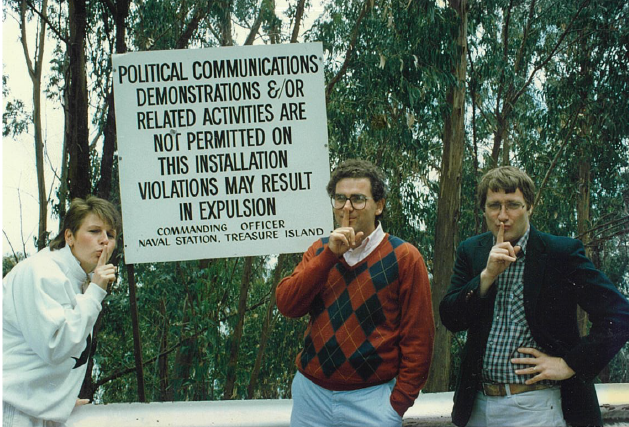
On manufacturing industry, MacBean had a more protectionist bent than what was popular in Canberra. Keating saw him as “not understanding tariff policy” or the changing economy. MacBean thought Keating had become arrogant and out of touch.
In the late 1980s and early 1990s, I was involved in many meetings and negotiations on redundancy and structural change. Manufacturing was shrinking. It was satisfying in some instances to negotiate generous packages, including vocation training, extended notice, and generous severance arrangements in industries as diverse as clothing & textiles, whitegoods, tyre manufacture, food processing, railway workshops, etc.
At a rowdy, early morning meeting of workers at a shutting-down section of a cigarette manufacturing site owned by WD & HO Wills at Pagewood in Sydney, Glen Batchelor, a left-wing organiser of the Plumbing Trades Employees Union, quipped to me afterwards that our training in Young Labor had prepared us well for the meeting we had just held. We were used to being shouted at and holding our nerve. (I had the added advantage of being half-deaf. Interjections did not rattle me much. I rarely heard them clearly!)
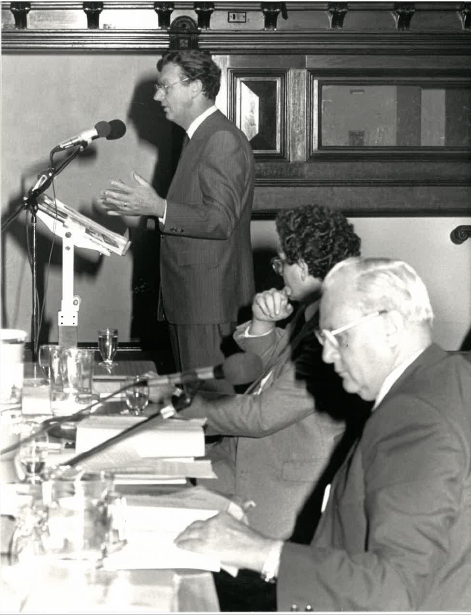
In late 1988, John decided to quit for appointment as a Deputy President of the Australian Conciliation and Arbitration Commission. I sensed that he was traumatised by the tensions with Keating, and separately with Kelty on the union reform agenda, and upset at the NSW election loss and its implications. We had goodwill towards each other, though I was never as close to him as to Barrie, who was like a father-figure to me.
Ironically, with Keating and the left unions, MacBean played a major role in bringing them closer, at least to a position of wary respect. In 1985 when Keating was promoting comprehensive tax reform, including a consumption tax, MacBean convened a meeting of all the major unions at the Labor Council. The leadership of the building, maritime, metalworkers and other big unions were in the room, Tom MacDonald, Tas Bull (1932-2003), Laurie Carmichael (1925-2018), and others, writing-pads in hand, furiously noting everything said. It was one of Keating’s better days, as he sought to justify the overall package as progressive, fair and of overall net benefit to the working poor. He was defending Cabinet’s endorsement in May 1985 of a draft white paper on options for tax reform. The paper recommended “Option C” – a reduction in marginal income tax rates offset by a broad-based consumption tax. For many of the left union leaders, more than a few of them members of parties to the left of the ALP, they were meeting Keating for the first time and in a convivial environment. As one of the communist leaders, the Federated Engine Drivers and Firemens’ Association’s Jack Cambourn (1928-2015) told me at the time, he saw that Keating had “a framework” to think about policy and to judge its utility. This was a revelation to him and others.
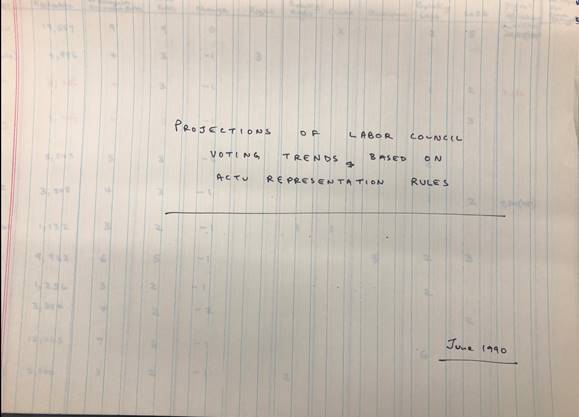
Stay Neutral
MacBean asked one thing of me: that I stay neutral in the looming NSW TWU ballot, due in early 1989. In fact, he said everything depended on my complying. John thought he could guide the relationship with the likely incoming leadership, and we needed to play a delicate game. He too realised the stakes. John had got close to Harry Quinn (1918-2008), the NSW Secretary of the TWU who in 1983 suddenly succeeded Ted McBeatty, drowned in a boating accident. In 1988, the Sydney sub-branch secretary of the union, Ted Edwards, was running to succeed Quinn, with the latter’s support. Edwards was someone MacBean thought we could work with and rely on, despite his closeness to some figures on the left. I am not sure what staying neutral meant, as the Labor Council officers no longer had any slush funds to assist in union campaigns. This was deliberate. The right-wing ALP officers now filled that vacuum.
One Sunday in December 1988, I drove to St Clair, to meet Steve Hutchins (1956-2017) at his home, to express my moral support. I knew Steve from our days in Young Labor. I had asked John Tolley (1944-2014), an industrial officer at the Labor Council, to privately help in the campaign and to do that for me. Donations were raised, Tolley told me, but that all went to the ALP slush fund to support the John McLean (for secretary)/Steve Hutchins (for assistant secretary) ticket for the TWU, NSW Branch. In March 1989, the McLean ticket won. The victorious ticket leaders thought I had done nothing for them. Henceforth, Hutchins was mildly hostile. He had gone to school with John Della Bosca, Michael Lee (a member of the Keating Cabinet), Seamus Dawes, and was then great mates of Della. There were a close-knit group.
Tolley wanted me to name him as my candidate for Labor Council assistant secretary instead of Peter Sams. I refused. Tolley left the Labor Council early in my term as Secretary. He was a fine man, whom I learnt a lot from, including calling another’s bluff.
(I remember one night when I was acting secretary, early on a Thursday night the evening of the weekly meeting of delegates to the Labor Council, Mary called in hysterics as she had seen a mouse running around the house and we had a young baby, Louise. I could not abandon Labor Council, or so I felt. I despatched Tolley. He drove to Ashfield, where we were living next to an old-fashioned convenience store, bought a mouse trap, and asked Mary for peanut butter and a carrot; he sliced off a small piece smothered in peanut butter and set the trap. Before I had got home that night — snap! — the target caught.)
In the election in February 1989 for Labor Council secretary, I was opposed by Brian Beer, NSW assistant secretary, Amalgamated Metal Workers Union (AMWU), now the Amalgamated Manufacturing Workers Union. He was a dour figure, on the Labor left, progressive, thoughtful, self-educated — the type of person you were thankful for the movement producing and developing. I won with over 65% of the vote.
Peter Sams became my deputy as assistant secretary, Beryl Ashe the senior organiser (the first woman in that role), together with Michael Costa (the first non-Anglo-Celtic elected at the Labor Council) and Mark Lennon as the other elected organisers. Tolley decided to leave and joined LinFox, the transport company, in Melbourne.
A team of talented people formed around me. I encouraged everyone to think for themselves, challenge my view in our discussions, and never stop thinking.
Ten Challenges
There were significant challenges:
First, the Labor Council needed to re-evaluate its role in the light of changes to the Australian and NSW industrial relations systems, including the political, economic, and organisational landscape.
Second, and related to this, the ACTU was busy restructuring the unions with little internal challenge or dissent.
Third, union membership levels were in steady decline. Could the Labor Council play a positive, pro-active role in reversing decline and assisting recruitment?
Fourth, the Labor Council had become irrelevant to the superannuation and financial services sectors. Was there a useful role to play?
Fifth, the distinctive voice of the Labor Council in the affairs of the Australian labour movement was in danger of being muted or unheard, as the movement was rapidly evolving. (I thought at the heart of this challenge was the need to have something to say in the first place.)
Sixth, an economic recession was unfolding.
Seventh, effective financial management loomed as vitally important due to the economic downturn and because the Labor Council was unprepared for the cutback in funded positions by the state government to the Council.
Eighth, the wholly owned radio Station 2KY was brimming with potential administration and financial challenges.
Ninth, a new conservative government in NSW claimed a mandate for industrial relations “reform” — the kind that would weaken affiliated unions. What strategies and tactics were merited?
Tenth, and related to the last point, there were many calls, not just from conservative circles, for changes to the Australian (and NSW) industrial relations system. That required careful examination.
I relished dealing with those ten challenges.
Getting Our House in Order
On the first challenge, the issue of the Labor Council adapting to the times, I encouraged the staff to debate issues and ideas about what should be prioritised. I then refined those ideas and subjected them to challenge and the development of fresh-cut insights with a sub-committee drawn from a cross section of unions. At the 1990 Labor Council Annual General Meeting, I reported with these observations:
1. The growth in federal award coverage had become considerable in many industries; for example, only from the mid-1970s have the building and metal industries become primarily federal award areas.
2. State Commissions had become less and less important as pacesetters and as ‘players’ in the overall system. The national tribunal was now easily the most important industrial tribunal in the land. Its guidelines were usually adopted with minor changes by the state tribunals. This trend has accelerated since 1975 and the onset of a more centralised system.
3. The NSW Industrial Commission — the historic innovator in fields such as long service leave, penalty rate arrangements, pay equity, redundancy and other benefits — had now become a conservative backwater. Unions regularly complained about the pettiness and intransigence of senior members of the NSW tribunal when it comes to the task of administering industrial assets.
4. Unions have considerably expanded their resource base and this trend has accelerated with union rationalisations and amalgamations.
5. The Labor Council’s affiliation fees allow it to have a resource base equivalent to the size of a union with less than 15,000 members.
6. The ACTU had grown over a decade from a small show — one full time president, one secretary, one research officer, one industrial officer and various support staff — to a large secretariat of the national union movement.
7. With union rationalisations, there should be fewer demarcation disputes requiring the assistance of the Labor Council.
8. With larger unions being created through merger and amalgamations, those unions increasingly prefer to do their own things.
Labor Council had to fit within and adapt to the parameters created by those factors. More of the same would not do. The Labor Council would (hopefully) always be a forum for debate in NSW and could also prompt, nudge, guide, and initiate action for the betterment of the movement.
As part of putting our house in order, I had to consider the position of Ernie Ecob (1930-2000; NSW AWU Secretary, 1980-1993, Member of the Order of Australia from 1988), the honorary Labor Council president. He was a mostly decent union leader who, however, had a full deck of flaws – insecurities, paranoia, anti-Asian suspicions, misogynist attitudes.
Some might be tempted to say old-school AWU, except that is not how I found, say, Reg Mawbey (1927-2011), his predecessor as NSW AWU Secretary. Ecob’s gift for saying something excruciatingly memorable added to the drama of knowing him. Interestingly, Ecob’s most steadfast and articulate supporter was Marilyn Dodkin, his former secretary turned office manager, come Labor historian. To his credit, Ecob encouraged her to pursue university education. A son of a Baptist minister, Ecob never swore in her presence, she said. Dodkin saw him as a humble servant of the labour movement, personally generous, warm and courageous in the pursuit of justice. Yes, in some ways a throwback in some of his thinking, she advised me; but a man representative of a part of the labour movement’s base which is scorned at our peril.
In early 1989, Ecob publicly used a racist remark which prompted me to say to him privately, and later publicly, that he could resign or be sacked as President of the Labor Council of NSW. I was not sure if I could easily do the latter – as he had been elected to office. But he accepted my request. As he sometimes also made various patronising comments about women, I had to move him out. It was only ever a matter of time. But I created an indefatigable enemy who mattered later on. In the job I was in, you had to spend goodwill capital for the greater good.
There was a collaborative and productive spirit among those people who worked with me. One of the incidents referred to in the assessment of my secretaryship, to which this is a Postscript, is discussed by Keri Spooner in her review of the union movement in 1989 wherein she wrote:
Two officials of the Labor Council of New South Wales prepared a document concerning the role of unions, in which they expressed views contrary to the prevailing views of unions in 1989. The document was leaked, and a number of left unions, as part of a struggle to increase their representation on the Labor Council’s executive, voted for the dismissal of the two officials on the basis that they thought and wrote words contrary to prevailing union philosophy. There were two particularly interesting aspects of the incident. First, the Academic Association, a body usually at least officially committed to freedom of thought and expression, was signatory to the motion. Second, one of the officials was actually dismissed, which goes a long way toward supporting a theory that the fraternal bonding and loyalties which once held the Right together have passed with the changes in personalities. (‘Australian Trade Unionism in 1989’, Journal of Industrial Relations, Vol. 32, No. 1, March 1990, p. 142).
On the comradeship and loyalty point, the bonds were as strong as ever. Sadly, the official who was dismissed withheld from me and John Whelan, the Labor Council Vice President who conducted an investigation on the leak, that he had privately circulated the document to a former colleague (who gave it to Lindsay Fox, who sent it on in a chain to the Leader of the Opposition, Andrew Peacock, who then leaked the document “exclusively” to select print media in Sydney and Melbourne.) If I had of known that the discussion paper was shared with anyone outside of the office (something explicitly denied by the person in question), I would have devised a different strategy to deal with the matter. Whelan and I reported to a meeting of hundreds of delegates to the Council our initial findings, and now weeks later someone leaked in the media the way the document had come to light (which was the first I knew of that.) I had to act when I knew I was misled, and that truth was withheld. (The first I heard of how the paper leaked was in a newspaper report in the Sydney Morning Herald in December 1989. Someone was skiting.)
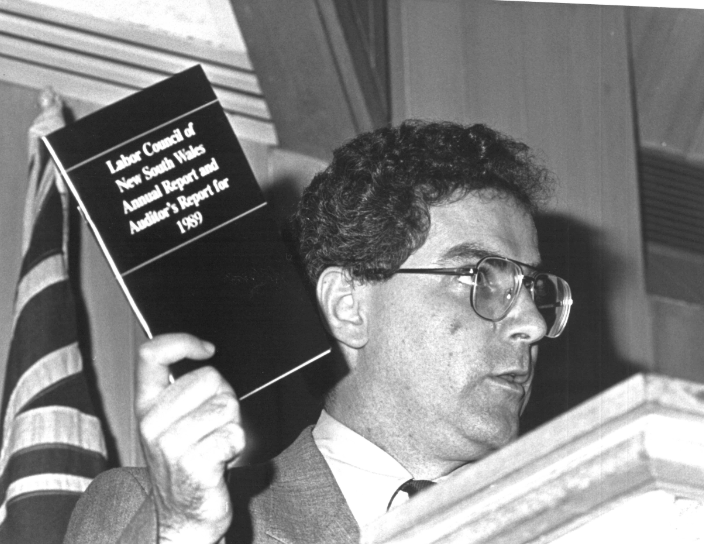
Union Amalgamation, Union Reform
Second, concerning the ACTU, I encouraged my deputy, Peter Sams, and Michael Costa, to speak their minds. With the support of Greg Sword, national secretary of the National Union of Workers (NUW), the old Storeman and Packers Union which, from 1989 following various amalgamations, became the NUW, I convened a meeting of unions concerned about union restructuring and mergers. We wanted case by case assessments. Some natural allies peeled away, with the ACTU offering to help facilitate favourable amalgamations for would-be dissenters. The national secretary of the Federated Ironworkers Association (FIA) union, Steve Harrison (1953-2014), was one person who spoke out against the ACTU leadership changing the complexion of the movement. He came to see their merits, later. Who could blame him? Everyone had to reckon what was in their organisation’s and members’ best interest. In 1991, the FIA amalgamated with the Australasian Society of Engineers (ASE), who covered metal industry tradesmen, to form the Federation of Industrial, Manufacturing and Engineering Employees (FIMEE). A year later, the Australian Glassworkers Union and the Amalgamated Society of Carpenters and Joiners amalgamated with FIMEE. The latter merged into the AWU in 1993. ACTU opposition could have stymied any one of those moves.
The Labor Council’s critique was that union amalgamations typically led to significant redundancy costs (as officials left or were retrenched), often led to significant membership loss (not everyone felt at home in a conglomerate union), and the combination of such pressures led to an inward focus, rather than innovation for survival.
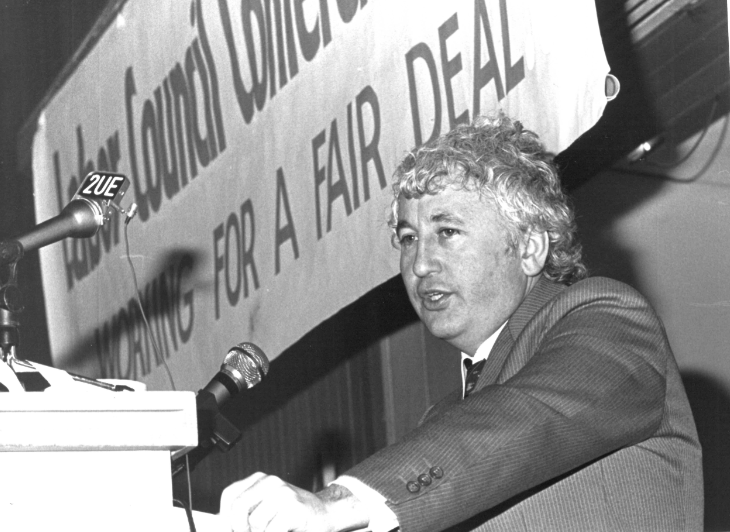
Sadly, the AWU-FIMEE laboured under huge transaction costs of mergers (redundancies, primarily), loss of focus, financial strife caused by a rapid decline of metal manufacturing and the steel industry in the early 1990s, compounded by an economic recession. There were years of leadership turmoil, resignations, and sometimes sackings. One result was a significant loss of members, fewer people to fight the battles, fewer resources to service members.
In many workforces, though not all, there were too many unions fighting over membership, sometimes causing industrial disputes. This was mainly concentrated in the building and manufacturing industries — the latter a rapidly shrinking part of the workforce.
Sitting on top of an anvil bench was not the perfect perspective for every industry. The Labor Council officers queried whether in some sectors significant membership loss would occur with bigger-is-better amalgamations. As Patricia Staunton, head of the NSW Nurses Association, once said to ACTU secretary Bill Kelty that not everyone is thrilled to be a member of conglomerate union No. 8. They liked their industry identity such as nurses do. What mattered most with individual unions was service, effective management, and value-for-money for members and potential members.
The Labor Council was ineffective, except at the margins, in running this critique. In 1993, I objected to the proposal in a draft Industrial Relations Reform Bill, proposed by the Minister Laurie Brereton, that unions smaller than 15,000 members be de-registered or forcibly amalgamated. In part, my argument was that this proposal would be a breach of ILO Convention 87. Articles 2, 3, and 4 of that convention clearly prohibited the government’s proposal. The relevant articles from that Convention read:
Article 2:
Workers and employers, without distinction whatsoever, shall have the right to establish and, subject only to the rules of the organisation concerned, to join organisations of their own choosing without previous authorisation.
Article 3:
1. Workers’ and employers’ organisations shall have the right to draw up their constitutions and rules, to elect their representatives in full freedom, to organise their administration and activities and to formulate their programmes.
2. The public authorities shall refrain from any interference which would restrict this right or impede the lawful exercise thereof.
Article 4:
Workers’ and employers’ organisations shall not be liable to be dissolved or suspended by administrative authority.
Given that the government claimed that ratified ILO Conventions provided new heads of power in the corporations, industrial relations, and related areas of the law, it seemed reasonable to stick to the Conventions. Cancelling union registrations defied the right of workers to join any organisation of their choice. I knew the government’s move was a ruse to demoralise some smaller unions to give up fighting for their independence. The legislation, ultimately, dropped that provision. Before that happened, I decided at a meeting of ACTU representatives to vote against the draft Bill in its entirety because of that proposal. It annoyed the ACTU leadership that I did so. The mindset was that it was ‘obvious’ and ‘necessary’ to force through amalgamations. For some minds made up, nuanced, case-by-case analysis can look too ‘academic’.
Declining Membership
On the matter of weakening union density numbers, the third point above, I thought we could address this challenge by extending union services and representation. Many of the Chapters in the book I edited with Michael Crosby, What Should Unions Do? (Lloyd Ross Forum/Pluto Press, 1992) addressed those issues. Naively, I had hoped that Chifley Financial Services, might also be a reason to join unions. Good services were provided by Chifley, but it was not the big game-changer that I had hoped for.
I came to believe that union fees were a problem and something along the lines of associate membership (or gradations in fee levels) needed exploring. Calling someone an “associate member”, however, might imply that they were less than a full member and in a second-class category. The marketing needed careful calibration. Indeed, none of my Labor Council team thought “associate membership” called as such would be appealing. The basic issue was “what should unions do”?
My conclusion was that the individual unions needed to tailor their policies and organising activity to their industry(ies) and make the right calls on how to win over and represent members. The Labor Council role, besides the actions we took in the industrial relations process, on behalf of and in consultation with affiliates, was to be a clearing house, a forum, for fresh ideas and sharing of experiences.
Financial Advice and Super
On the fourth challenge in 1988, as assistant secretary, I had another go at forming a public-offer superannuation scheme, Asset Super, as described in ‘The Secretaryship of Michael Easson’ article above. In 1989, as Labor Council secretary, I also looked at financial planning and advice, forming Chifley Financial Services (CFS), and later a Chifley trustee entity. CFS was formed with Brian Sherman’s and Laurence Freedman’s Equitilink company as a 50/50 JV. (I wanted entrepreneurs to be Labor Council’s business partners. These two South African migrants had built something from scratch.) David Goss, a brilliant marketing mind and driven entrepreneur, was appointed the initial CEO. I seconded Michael Costa to work with Goss over the first six months and then part-time in developing the business. As members of an independent advisory board, I appointed Jim Dominguez, a former investment banker, Gerry Gleeson (1928-2017), the former head of the NSW Premier’s Department, and Dick Warburton, the former head of DuPont Australia, which had an exceptional reputation in occupational health and safety and good management. I wanted their commercial and ethical oversight on anything we proposed in the area of financial advice and services.
Getting Heard
Fifth, the distinctive voice of the Labor Council needed new outlets. In 1990, the Lloyd Ross Forum was formed to air issues for discussion, publish research papers and books. Various publications were issued on topics ranging from industrial relations reform, to immigration, to industry policy, to a focus on modern unionism and new growth strategies. From across the broad ALP-aligned sections of the labour movement, the inaugural members of the Forum’s executive were: Jim Macken (1927-2019), Chair, former judge of the Industrial Commission of NSW; Patricia Staunton, NSW Nurses; Michael Crosby, Actors’ Equity; Steve Harrison, FIA; Liz Bishop, Federated Miscellaneous Workers Union: Professor David Plowman (1942-2013), University of NSW; Jeff Shaw QC MP (1949-2010); Michael Costa; and myself as Forum secretary.
I hired Social Change Media (as Ric Sisson’s company was then known) to help improve the Council’s image, the production of advertisements, and campaign material. Labor Forum and Labor Network journals were issued on thought issues and industrial campaigns generally.
The Recession
On the sixth point, the unfolding economic downturn was devastating. The Australian economic recession of 1990-91 saw a significant slump in employment (of around 4%) and sharp rises in unemployment (around a 5% rise to 11.2%). The recession was severe in terms of mass job losses, corporate collapses, and financial failures. Variable mortgage rates were 17 per cent, with consequential economic and social damage. This had profound effects, not all of which were fully appreciated at the time. Manufacturing industry significantly shrank. Union membership and union density diminished. The Labor Council which had nearly 1,000,000 members from affiliates in the early 1980s, lost 200,000 members by the early 1990s. That meant considerably lower capitation fee income. I cannot remember the per capita member formula ($1.80 per member?), but the financial impact was severe.
With the economic downturn in the early 1990s, all I could do was cut back on our expenditure to better match our income, better manage 2KY’s finances, and look to investing some funds in an asset that might provide an income and potentially grow in value.
Finances
Which brings me to the seventh challenge: Potential financial troubles loomed as, for example, the Labor Council had not properly prepared for the complete cutback in funded positions by the state government to the Council. As early as July 1988, the government wrote to Council saying it intended to cut all funding, unless compelling reasons could be provided for particular programmes. We thought some grants, in child-care and occupational health and safety, for example, would be kept going. The prospect of zero NSW government support should have been considered much earlier. In the 1992 Annual Report of the Labor Council I stated:
The Labor Council faced a financial crisis and this required the retrenchment of many loyal and competent staff. A change of government in NSW in 1991 did not eventuate, therefore a reversal in funding cut-off to specialist officers by the NSW government did not occur and the Labor Council’s reserves in various specialist accounts dried up. In addition… the drop in the affiliation base meant that the Labor Council needed to face up to the reality that an exponential blow out in the Labor Council’s deficit was unsustainable.
Some painful re-organisation and retrenchments were made. The chief reasons for which bear further elaboration.
With the Labor Council’s finances, there were healthy reserves generated from years of profits from the radio company. Over 1989/1990, the reserves were partially drawn to cover the cost of shortfalls in government funding for specialist officers. The tougher economic times, however, began to bite. 2KY was no longer a cash cow. Capitation fees from affiliates were frozen. Inflation, as mentioned, was steeply rising. Many affiliate unions lost membership in the carnage of manufacturing industry decline, with hundreds of thousands in job losses. Additionally, many unions decided to reduce their reported number of members to Labor Council to reduce fees. In combination, this required me, like a shrewd businessperson, to reset the business, shed costs, restructure. I thought the cash reserves of the Labor Council would be seen by some affiliates as an excuse to say that Labor Council should draw down on our resources while everyone else was doing it tough.
In 1989/90, Stephen Loosley the then General Secretary of the ALP wanted the party (then and now on the 9th floor of the Labor Council building, one floor below the Labor Council’s then offices) to move out from our shadow. The ALP was in financial difficulty, over-extended, through his purchase in 1990 for $3.8 million of a property at 291 Sussex Street, near the corner of Bathurst Street in Sydney. The collapse in the value of the Sydney property market, saw the halving of the property’s value, with the ALP breaching loan covenants with debt serviced at an interest rate nearing 20% per annum. As the ALP struggled to meet its repayments, the problem was literally compounding.
As the party fell into deeper debt, Loosley was deemed the culprit. This eventually cost him his career as a Senator for NSW (1990-95) with the problem handed over to his successor as NSW secretary, John Della Bosca. “Della”, I had a good deal of time for. We were allies in Young Labor. When Loosley was leaving for the Senate he (and Richardson) considered Peter Fitzgerald, the general manager of Botany Council and Mayor of Drummoyne as ALP General Secretary. Della, Hutchins and I met numerous times to scuttle this plan. Carr and MacBean, by now Leader of the Opposition and Labor Council secretary respectively, agreed that Della deserved the role and pushed to appoint him.
As for the ALP’s finances, Della evinced sunny optimism. Affiliates would come good. Donations were strong from business. As I had not sought a position on the NSW ALP Administrative Committee, I was remote from the detail. But I knew what not to do.
I knew Tony Berg, the CEO of Macquarie Bank (we both served on the board of the State Rail Authority from 1989-1992) and I asked him for advice. He put me in touch with Bill Moss, the head of property at Macquarie, and Moss looked out for potential properties to buy. I visited a number and in December 1991 settled on the 10-storey 2GB building as it was then called at 364-372 Sussex Street at the corner of Liverpool Street. A commercial office tower, with retail on the ground, the building had good income, lease security, and on the top floor were the studios of radio station 2GB. Macquarie Bank’s advice was that if we could ride through the recession, it could considerably increase in value, as it was in walking distance to Town Hall station, Darling Harbour, and China Town. (Bill Moss joined the ALP as did George Newhouse, the lawyer from Fred Swaab & Co., who assisted on the transaction. George is still a member, Bill dropped away early. They were excellent counsel. Bill also tried to convince me that the Labor Council should take a stake in Aussie Home Loans. I should have agreed.)
With the 1991 NSW state election ahead, I put Beryl Ashe in charge of the Labor Council’s Save Our Services (SOS) campaign. It was a model for garnering community support for services and undermining confidence in the Liberal-National coalition’s custody of certain services. This campaign naturally appealed to the public sector unions, such as the Public Service Association, the NSW Teachers Federation, the NSW Nurses Association, and other unions which had decided not to affiliate to the ALP — but were affiliated to the Labor Council. Information material (propaganda, perhaps, but written in a non-strident way, with the middle-of-the road centrist voter in mind), some rallies, but mostly calmly organised community meetings, including in numerous parts of regional NSW, and radio and television interviews, and advertising featured. Including the Labor Council’s contribution, nearly a million dollars in donations and in-kind resources was raised for this campaign.
With a few weeks to go before the NSW state election in May 1991, I received an urgent phone call from Della Bosca who asked that I see him immediately. Naturally, I agreed. He arrived at my office sweaty and desperate. He said that the Commonwealth Bank had threatened to foreclose on their loans on the ALP property, as numerous breaches in loan covenants had occurred. He needed an immediate cash injection of $1.0 million. He feared this horrendous situation could leak. If anyone heard of this, Labor’s prospects in the poll would be drastically undermined. “We will get smashed”, he said. I said that the Labor Council needed to secure any loan with equity in the property. I needed the legal papers to be drawn up. He said there was little time. But he could get Greg Keating, partner of McClellands solicitors, to see me. I said I would need 24-hours to think about the idea and that I would want to see Greg Keating, the NSW ALP’s principal lawyer, to discuss the commercial arrangements. Della agreed. He begged me to think if I wanted to be responsible for wrecking Carr’s prospects if this got out. I spoke to Sams, Ashe, Costa and Lennon, swearing everyone to secrecy. “What choice did I have?” was the question posed back to me.
The next day, I met Greg Keating who assured me that this would be a short-term loan. Della interrupted to say: “You’ll get your money back” saying that it might take a year, it might be sooner, but minimum $100k monthly instalments would be made after the dust cleared from the election. Security would be provided through a third of the equity in the building being vested with the Labor Council until the loan was repaid. Della said that there had been a surge in donations to the party. The Greiner government, he claimed, was seen by important sections of business as wobbly. I asked to see the documentation on the agreed position. Both Greg Keating and Della said there was no time to draw this up “but you have our word”. I believed them. I signed a cheque for $1.04m, handed it to him, and that was that.
Thereafter my relationship with Della soiled. I kept asking for the transaction papers. Like a junkie satiated from his fix, he was not interested in discussing anything further. The election campaign budget had blown out. There was no money to pay anything back, though countless promises were made over the months and years ahead. Apparently, Harry Triguboff the founder of Meriton was interested in buying, rezoning, and turning the building into an apartment site. “You’ll get your money back then”, Della promised. This rigmarole continued for years. I better appreciated the old Irish curse “I do not know why he dislikes me so much. I cannot remember the favour I did for him.” Except, in this case I and my Labor Council colleagues did. $1.0m was a lot of money in those days and was needed to keep the Labor Council in a comfortable financial position.
In early 1992 I reported to the Labor Council meeting, to all the delegates, on the situation having in the year before kept the Labor Council Finance Committee in the loop. The 1991 Annual Report of the Labor Council of NSW explained everything. Della reacted with fury angrily calling up to my office, denouncing me for breaching “confidentiality”. I said I would no longer play games. I needed to be totally frank with all. Delegates from Labor Council, from left to right, overwhelmingly backed me.
In the 1993 Annual Report of the Labor Council of NSW, I mentioned that green shoots of economic recovery were showing. And that:
Even the ALP debts seemed to take a turn for the better with healthy negotiations between the Labor Council and the ALP on outstanding matters. The key issues remain unresolved, but the ALP’s optimism about developing the Labor Centenary House site and related environs is a strong note of hope about their financial problems and the prospect of recovering some of the money owed to us.
Della reacted with consternation at those mild words. As if I should forget the debt. I regretted losing a friend in all this, but I could hardly not report to Labor Council what was going on. (A detailed account of the Labor Council/ALP debt issue appeared in a story by Kate McClymont and Colleen Ryan, ‘Labor’s Crisis: Others on the Brink’, Sydney Morning Herald, 9 February 1993, p. 11. Airing our dirty linen in public was not in anyone’s interest. I have a good idea who fed this story to the journalists.)
Radio Station 2KY
On the eighth point, concerning radio station 2KY, I had three major concerns – programming, financial viability, and potential on-going contractual arrangements with the TAB. In soliciting authors for various Chapters for the book co-edited with Michael Costa, Australian Industry: What Policy? (Lloyd Ross Forum/Pluto Press, 1991), through Clem Doherty, the former head of McKinsey in Australia, I came across McKinsey’s David Harrington. I hired him and McKinsey to give me some strategic advice (at cheap rates compared to what they normally charged.) He reported on ideas to make 2KY more viable. One was to exploit narrowcasting licenses. The same idea, simultaneously, occurred to Barrie Unsworth. (2KY had been owned by the Labor Council from 1925 onwards. It was known as the “racing station” as we covered horse racing and other track events. We also specialised in country music and employed some shock jocks who strayed from civilised thinking on some issues. At the time, the “recession we had to have” in Paul Keating’s phrase, affected advertising revenue, and therefore station profitability. Management was everything. Barrie was at a bit of a loss for things to do post retirement from politics in 1991. He was too young and energetic to retire. Station management was taking too much of my time. From his time as Labor Council secretary and managing director of the station, I knew Barrie loved the media business. In 1992 I hired him as station manager reporting to me as managing director. He was an excellent appointment, diligent on micro-management and strategic on the broader, delicate, relationship with the TAB. In 1992 I posted Michael Costa to work as Barrie’s assistant manager at the station, to deepen his commercial expertise early in his period at the Labor Council, and to be mentored by Barrie and thereby better understand our traditions.
The narrowcasting challenge amounted to this. Every two years the TAB, then a NSW government statutory authority, negotiated a contract on broadcasting the races that they covered. Therefore, every few years this contract was in jeopardy. The TAB paid 2KY to broadcast what they wanted. The station’s schedule was built around that. Some other radio stations sought the right to broadcast for the TAB. For an exclusive contract, there was competitive tension. What Harrington suggested and, independently, Unsworth quickly sniffed as an opportunity, was to spread the coverage of the broadcasts beyond 2KY’s antenna tower at Homebush Bay — which reached metropolitan Sydney. Under national legislation, cheap broadcasting licenses were issued by the Federal Department of Communications for broadcast of content in the regions. The proviso being that the content could not compete with existing, local stations. Almost no stations in regional NSW comprehensively broadcast the TAB preferred racing schedule. To make sure of the continued validity of the narrowcast licenses, only the racing commentary, previews, associated programmes, as well as the races, and the odds nominated by the TAB, were broadcast under the narrowcast licenses. 2KY’s breakfast, late evening, and Sunday night programmes, for example, were not streamed to the regions. Only the racing material was.
Barrie organised the purchase and lease of satellite dishes and associated equipment that could capture the 2KY TAB feed, then broadcast that to targeted geographical areas of the state. Slowly and surely, nearly 40 narrowcast licenses were granted across NSW — and this continued to grow after my time in the job. This meant that the TAB coverage became state-wide and what was being broadcast was more extensive and valuable than before. 2KY became Australia’s largest narrowcaster measured by a number of services, number of persons reached, and area covered. Because 2KY or its subsidiaries held the individual regional licenses, it would be harder for the TAB to dislodge the incumbent (2KY). In 2001, after my time as secretary, when Michael Costa was in the role, the TAB purchased the station. They feared that the Melbourne-headquartered Tabcorp Holdings Limited might seek to usurp their place in NSW by either offering a more lucrative broadcasting agreement to 2KY or acquiring the station, including its narrowcast licenses.
Industrial Relations “Reform”
Ninth, as elaborated below, with the Greiner government proclaiming the need to crack down on unions and curtail strikes, a swathe of legislation was introduced in the NSW parliament. The Labor Council, as the above paper highlights, needed to deploy various and creative ways and means to thwart the government’s actions. As assistant secretary, with the assistance of Donna McKenna, the Council’s Legal Officer, I co-ordinated and did much of the writing of a comprehensive document, A Fair Deal at Work. The Union Movement’s Agenda for Industrial Relations Change in New South Wales (1988) which explained the Council’s philosophy and approach on industrial relations and social policy and advocated the case for continued NSW state government funding of the Labor Council specialist positions.
The book I co-edited with Jeff Shaw, Transforming Industrial Relations (Lloyd Ross Forum/Pluto Press, 1990), presented a powerful, initial critique.
In the early 1990s, there were many proposals and changes to the Australian and NSW industrial relations system, including competing worldviews on enterprise bargaining, flexibility, and claims about fairness versus efficiency, which took up a lot of my energies. All this necessitated thinking about the existing state and national systems of industrial relations law and policy and cutting through some of the ideological pretensions of many of the parties.
At times, the debate felt reminiscent of remakes of the Star Trek movies, but without the excellent scriptwriters. The same characters, familiar postures, saying what you would expect, and taking a long time to do so, dominated the picture.
The Labor Council’s take on the issues was simple. We recognised the imperative for greater flexibility and enterprise negotiations, and the importance of curbs on inter-union conflict and frictions that mitigated against the orderly management of industrial relations. We were alert too to uncritical use of phrases and concepts. Did ‘enterprise’ mean a single workplace, or all of the workplaces combined of a particular business? What does ‘flexibility’ mean? Compared to what? It is a relative term. We advocated the merit of the ampersand. Could not fairness and efficiency be combined? Unintended consequences needed assessment, not just ideological optimism.
Additionally, though we did not put matters in such terms, we argued like Burkeian reformers — suggesting that piecemeal change was better than radical transformation. The Anglo-Irish political philosopher Edmund Burke (1729-1797) saw that “laws like houses, lean on one another,” that abrupt change threatened the foundations, and that moderate reform was almost always more appropriate than something more substantive.
To some excitable eyes, however, dramatic change looked ‘radical’ and appealing. Shakespeare’s Prince Harry captured a timeless mood:
…like bright metal on a sullen ground,
My reformation, glitt’ring o’er my fault,
Shall show more goodly and attract more eyes
Than that which hath no foil to set it off.
The argument that something spectacularly new and shiny is better than that which is familiar, dully sturdy, and evolving, is an old argument. The Labor Council officers believed in civilising capitalism, neither destroying nor championing it. The NSW government at the time sounded like Prince Harry in Henry IV.
In NSW, unlike the Federal system, there was a long-standing legislative arrangement under s.11 of the NSW Industrial Arbitration Act to allow for enterprise agreements. At the time the NSW government finally succeeded in 1991 in getting its industrial relations legislation through the NSW parliament, we argued that the fact that there were 2000 registered s.11 industrial agreements in NSW was testimony to the ‘flexible’, adaptive features of the NSW system. Essentially our plea was ‘more to do, but on the right track’. Could we not tinker, amend, and enhance the NSW system with sensible reform instead of jettisoning much of the whole?
Truly, of all the matters I had to anticipate, respond to, and devise strategy about, industrial relations “reforms” dwarfed all the others.
In 1988 John Fahey (1945-2020), the Minister for Industrial Relations in the Greiner government, commissioned University of NSW Professor John Niland to research and report on possible changes to industrial legislation in NSW. In February 1989 Volume 1 of the Niland Green Paper Transforming Industrial Relations in NSW was issued. This recommended that new legislation embrace a greater “enterprise focus” compared to the existing system and provide for the recognition of the difference between “rights” disputes (which relate to the interpretation of the rights of parties to an agreement or award) and “interest” disputes (which pertain to the making of the terms of employment). The report proposed the latter be lawful and the former unlawful. Moreover, Professor Niland proposed that in any enterprise there be a “… mechanism by which workers in a particular workplace could decide which union [if any] would represent them as a bargaining unit within an enterprise.” And enshrine the right of employees to form bargaining units without unions. The proposed new system would facilitate unions negotiating enterprise agreements which would override awards or registered agreements as well as “the ability for groups of employees to enter into collective agreements with employers without the intervention of trade unions” and further changes as outlined in the article above which assessed my secretaryship of the Labor Council of NSW.
In December 1989, the Greiner government introduced the Industrial Arbitration (Enterprise Bargaining) Amendment Bill 1989 (NSW) — later withdrawn after opposition from all the major NSW employer bodies as well as the Labor Council.
In May 1990, the government introduced the Industrial Relations Bill 1990 (NSW) to repeal other legislation and to introduce a considerably modified system (“Niland Light”, as some said at the time.) The Bill was controversial and attracted criticism for a variety of reasons including the proposed denial of access to the processes of conciliation and arbitration, as needed; the unchecked ability for associations known as ‘enterprise associations’ to negotiate enterprise agreements; and very low proposed minimum standards applicable to enterprise agreements. This Bill was also withdrawn in October 1990, prompted by the likelihood that amendments supported by the ALP, the Australian Democrats, and MLC Marie Bignold in the upper house, were likely to be successful.
As a result of this legislative frustration, the government announced its intention to reintroduce legislation in a series of smaller, “bite size”, Bills.
The first of those was the Industrial Arbitration (Enterprise Agreements) Amendment Bill 1990 (NSW). Again, the Labor Council was active in critiquing the ideas in the Bill and proposed key amendments which would have: required notification to relevant unions of any application for an enterprise agreement; given any union with an interest in the proceedings the opportunity to be heard by the Commission before any application for an enterprise agreement could be ratified; and tighten the procedure for obtaining exemptions from awards. Those amendments were unsuccessful; the Bill passed through all stages in December 1990.
Flexibility and Relevance in the NSW System
In the May 1991 NSW State Wage Case — to deal specifically now and also briefly with point ten above — the Industrial Commission of NSW picked up on the need for clear guidelines to facilitate enterprise bargaining. This occurred after submissions were put by the Labor Council representatives (including myself), alongside contesting views by the employer associations. The 1991 State Wage Case principles announced on 29 May that year required that awards provide procedures for ‘enterprise arrangements’ which could alter and override award conditions. This principle wound back the NSW government’s more restrictive legislative provisions in that the Commission required the notification of relevant trade unions and gave them a right of appearance before the Commission. This was an important moment or so I thought in the evolution of guidelines for enterprise bargaining. The Federal Commission had questioned the “maturity” of the parties. But here in NSW Justice Bill Fisher, the President of the NSW Industrial Relations Commission had accepted the arguments of the Labor Council that in NSW we already had experience with enterprise bargaining and with new guidelines facilitating more flexibility in awards, there was nothing to fear. Complicating the situation, however, the NSW government expressed the intention for more legislative change. Even the NSW Employers Federation privately pressed the government to leave it alone. The ACTU seemed ambivalent, wanting a grand bargain with the federal government as part of the Accord processes.
News reports at the time evinced a positive reception to the NSW decision.
In March and April 1991, the government introduced new legislative instruments including the: Industrial Arbitration (Secondary Boycotts) Amendment Bill 1991 which sought to amend the Industrial Arbitration Act to provide penalties for individuals involved in secondary boycotts, and to provide that unions could be vicariously liable for any damage caused by a boycott undertaken by its members. The Industrial Arbitration (Unions) Amendment Bill1991 sought to amend the Industrial Arbitration Act 1945 and the Trade Union Act 1881 to enable and require the incorporation of industrial unions of employers, employees, and trade unions. The Bill required unions to comply with general standards of corporations’ law. The Industrial Arbitration (Unfair Dismissals) Amendment Bill 1991 sought to amend the Industrial Arbitration Act so as to provide for access by an individual employee to a Conciliation Commissioner where the employee claimed to have been unfairly dismissed or threatened with dismissal, without the need for that person to be a union member or represented by a union. The Bill also provided for financial remedies rather than reinstatement. This Bill passed and became operative in July 1991.
In November 1990, the government introduced the Industrial Arbitration (Voluntary Unionism) Bill which sought to do away with preference for union members and closed shops. This Bill was reintroduced in March 1991. Interestingly, the Bill stood in direct conflict with Professor Niland’s more liberal suggestions.
Immediately following the narrowly won May 1991 NSW state election, the government claimed a new mandate to proceed with its program of industrial relations changes.
In the 1991 Annual Report of the Labor Council of NSW, I observed that:
The Premier wasted no time in seeking to foment trouble with the union movement. A complicated Industrial Relations Bill was brought into the parliament. It repealed the Industrial Arbitration Act, the Trade Union Act and even cast aside the Greiner government’s own initiatives, including the enterprise bargaining amendments proclaimed earlier in the year. Labor Council and affiliates organised massive media campaigns and rallies against the Greiner approach. Labor Council spent over $400,000 in opposition to the Greiner legislation.
What happened was this: On 28 August 1991, the government introduced the Industrial Relations Bill 1991 which incorporated all previous proposals and beyond. As mentioned in the ‘The Secretaryship of Michael Easson’ article above, this was the largest piece of legislation ever introduced into the NSW Parliament. A battle royale lay ahead.
A day after the government tabled in the NSW parliament its proposed legislation, at the Thursday night Labor Council meeting on 29 August 1991, I reported that the government had introduced the most dramatic and draconian overhaul of industrial laws in New South Wales history and as a consequence the Labor Council would consult widely — with its affiliates, the Labor Opposition, the community, the independent members of parliament and other interested parties — to ensure that its more obnoxious features were removed.
Selection of Labor Council of NSW leaflets on industrial relations change in NSW in the early 1990s:
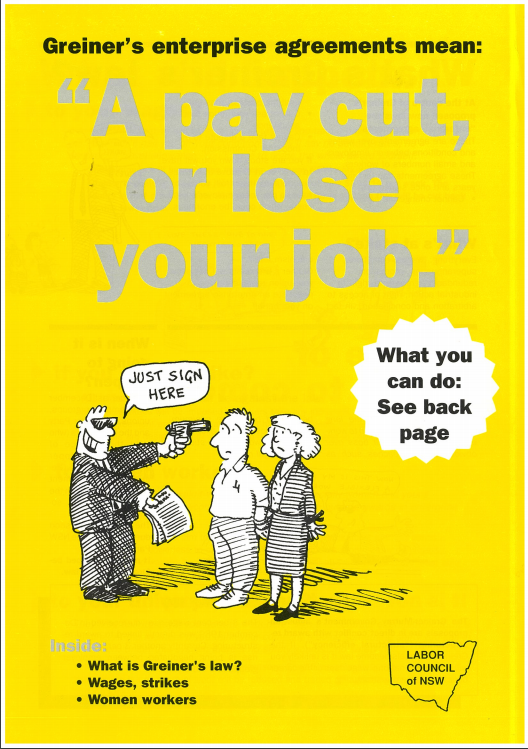
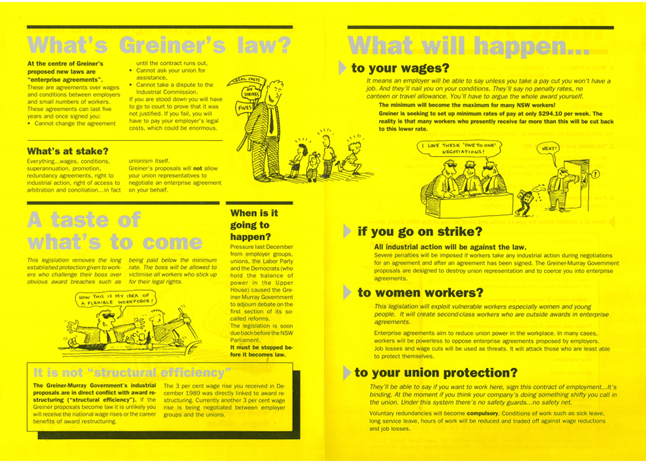
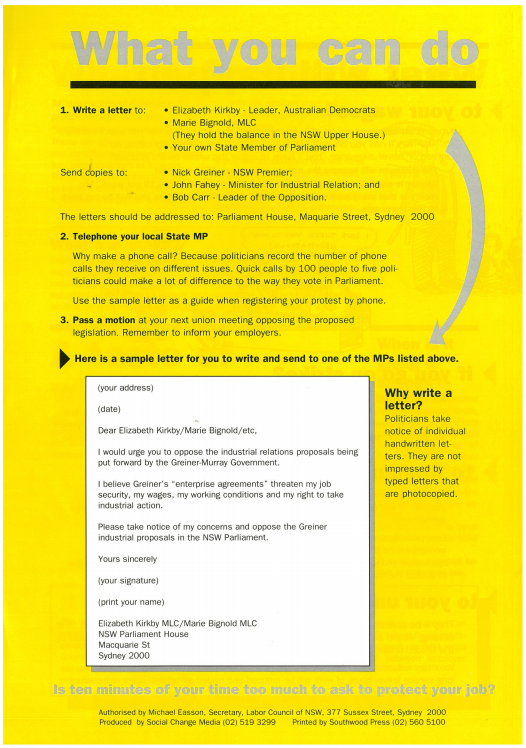
I detailed many of the objectionable features of the Bill, including:
-
- The removal of the public interest test and Industrial Commission scrutiny of enterprise agreements, prior to registration;
- Substantially inferior conditions of parental leave (maternity, paternity and adoption leave) to those applying federally – hypocritically supported before the Federal Commission by the NSW government only the year before;
- Totally inadequate statutory minimum standards for enterprise agreements;
- Removal of the standard 40-hour week – there would be no meaningful restraint on the total number of hours required to be worked in one week;
- Removal of long-established award protections for part time workers;
- Abolition of s.11 industrial agreements, which had served employees and employers well (e.g., the Sydney Harbour Tunnel Agreement.) All existing agreements would whither on the vine because they cannot be varied, even for State Wage Case decisions;
- Persisting with the unnecessary nonsense of a separate Industrial Court and Industrial Relations Commission;
- Abolition of the cost-effective Industrial Magistracy. Unpaid wages will now have to be pursued in the expensive and hopelessly overstretched local courts;
- Effective right of employers to avoid paying award-based superannuation to Commission approved funds;
- Startling and meaningless “right of entry” provisions for union officials seeking to protect their members’ rights, i.e., seven days’ notice to check books for underpayments.
The Bill passed through the Legislative Assembly (the lower house of the NSW parliament) on 26 September 1991, after the government gagged debate on over 50 ALP amendments including some proposed by John Hatton and other independent MPs.
Of the amendments argued over in the lower house, the most significant was the successful retention of the position of Chief Industrial Magistrate. On that point, the government conceded the merit of our representations.
The Bill then went to the Legislative Council, the NSW upper house. There was widespread opposition not only from trade unions but from a wide range of social and community organisations, including the churches. Years later, seeing him at a wedding that he officiated, Rabbi Brian Fox (1944-2020) told me that in 1991 he read aloud a letter from me as Secretary of the Labor Council to his congregation at Temple Emanuel asking for prayers for the leaders of the state government and parliamentarians to act wisely and justly concerning NSW industrial legislation.
From the phone book and other sources, we compiled addresses of as many churches and other religious denominations – Catholic, Christian, Muslim, Buddhist, Jewish, Hindu, and others – to set out our respectful request to contact local MPs and enquire about what they might be thinking and to pray for them. I added to the list the Humanist Society and the Rationalists’ Society — with appropriate changes in the language of the letters sent.
Some in the unions, Brian Beer in particular, was scathing – saying as if “getting down on your knees” solved anything. We wanted to seek as much support possible, however, and sow doubt in the minds of the government’s supporters.
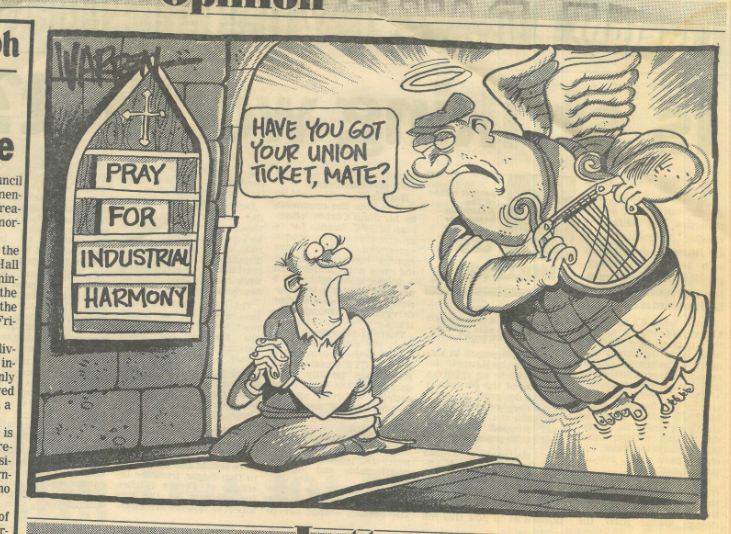
No tactic short of insurrection was off the table. The Labor Council organised the first state-wide strike in opposition to the Bill. Originally scheduled for a day when a sub-committee of members of the International Olympic Committee (IOC) were due in Sydney, I unilaterally changed the date. I did not want the union movement blamed for losing the 2000 Olympic Bid. The deferral helped win the case for Sydney. I presented to the IOC Bid assessment committee the week they were in town and feedback from the Australian members of the IOC was warmly positive.
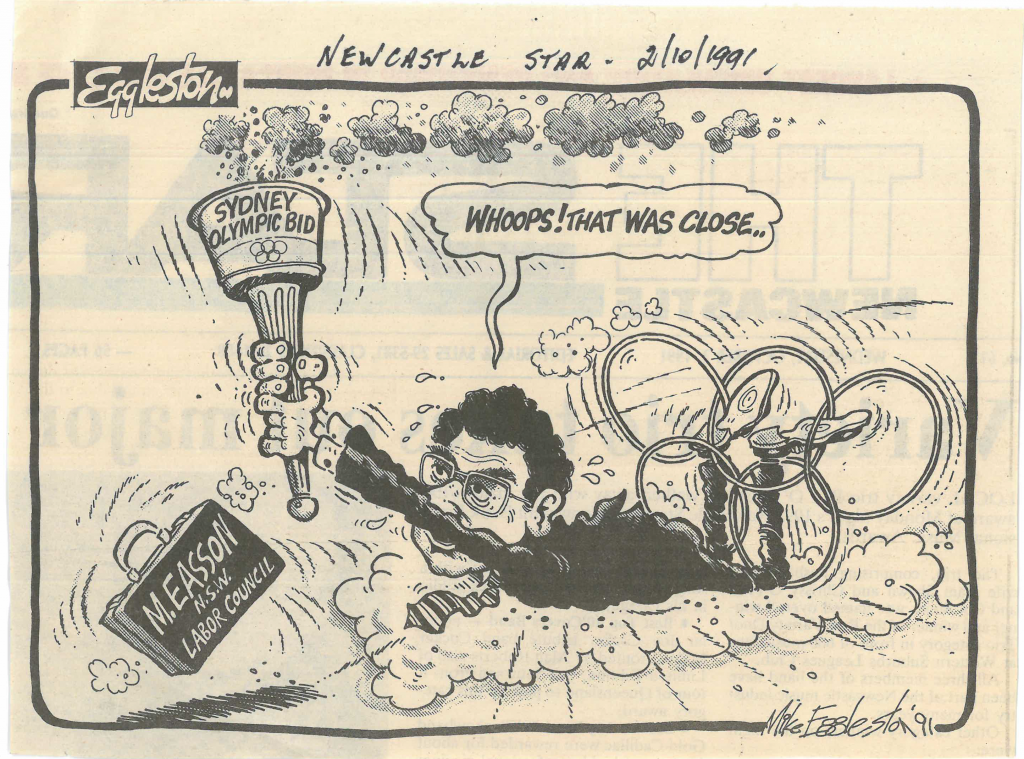
I also hoped that the government in the interregnum might rethink some points of contention. I was wrong to hope for that. The strike went ahead on 23 October 1991. One week later, however, with the support of the Call to Australia Party MPs, the Rev. Fred and Mrs Elaine Nile, the Bill passed through the Upper House at 12.40 am on Wednesday, 30 October 1991. (Fred Nile explained to me that his general policy was to support the government of the day, except on matters of faith and morals. I was unable to convince him that the government’s industrial relations legislation was an instance of the latter where a critical spirit was needed. We disagreed on the applicability of the parable of the labourers in the vineyard, Matthew 20:1-16, and other Biblical passages.)
On the night the Bill passed, some members of the Opposition were reported as singing ‘Solidarity Forever’ into the early morn. I was asleep at the time. I had to get up at 5.00am and field interviews on the morning radio stations.
The regulations were issued throughout 1991/2.
Next 7 photos taken from Labor Council Annual Report in the early 1990s:
The Act drew a distinction between settled and unsettled rights. So far as settled rights (that is, matters pertaining to the interpretation of existing awards) were concerned, industrial action was outlawed. Injunctions could be issued by the Industrial Court and the penalties for an industrial organisation were $100 000 and an additional $10 000 for each succeeding day and for individuals $10 000 and an additional $1000 per day. Conciliation and arbitration on matters considered to be settled was generally not available.
Most industrial action became unlawful. Industrial action in relation to demarcation disputes or sympathy strikes were open to penalties, as outlined. Industrial action in relation to unsettled matters was available but the Act provided that if a union considered such action, the employer or a single member of the union had the right to request a secret ballot to ascertain support for the action. The Act empowered the minister to direct that such a ballot be held even if the employer and the employee(s) had not requested it. This provision encouraged gaming of the system: unions could formally either simply avoid industrial action (with workers taking matters into their own hands and, perhaps, resort to forms of industrial sabotage) or the unions would take the risk of action with slow-to-organise and costly ballots.
Additionally, there was ongoing controversy and confusion as to how best to apply and, indeed, what was the law.
A list of minimum standards (sometimes far less than what was typically covered in key awards) were defined in regulation — e.g., five days per year sick leave, with a maximum of three years accumulation; the averaging of working hours to a maximum of 40 hours per week, averaged over 52 weeks. No minimum standards for casual workers. The provision for the review of enterprise agreements by the Industrial Commission and the right of peak organisations to put submissions in relation to the public interest were removed. The Industrial Court’s power to review any agreements which might be harsh or unconscionable was limited and could only be instigated through the application of a person directly bound by the agreement.
Other changes included the establishment of an Industrial Court to enforce awards and impose penalties. The then current judges (including the President of the Industrial Commission of NSW) were given dual appointments to the Industrial Court, whose jurisdiction extended to matters involving discrimination in employment arising under the Anti-Discrimination Act 1977.
The new Act stipulated requirements on unions for accounting and reporting procedures, rules of operation, and the election of union officials. Those were inspired by the 1989 review by QCs Roddy Meagher (1932-2011) and Dyson Heydon of trade union law, that was commissioned by minister Fahey. None of the new requirements were particularly onerous, and the provision enabling a state union to have rules which allowed officers elected to a state branch of a federal union to be taken to be elected to corresponding positions in the state union was sensible.
On the other hand, the legislation attacked rights such as the right of preference for union members (expressly forbidden). Awards for the deduction from wages of union subscriptions could not be made (even by consent) and those in existence ceased to have effect.
Union officers no longer had a right to enter premises and inspect wages and salary records without giving seven days’ notice; with no right to enter premises where they had no members. The legislation provided procedures whereby 65% of employees employed in an enterprise could vote for a rationalisation of union coverage.
Given that the Sydney Harbour Tunnel construction and the civil works at Darling Harbour were examples of successful s. 11 enterprise agreements, it was noteworthy that, with one sectoral exception, the government underplayed the good work already accomplished, including the mostly excellent industrial relations experiences. Many of those s.11 agreements had the Labor Council as the co-ordination party for the combined position of the unions. It was interesting that the government allowed an amendment to the Bill in the Legislative Assembly to enable comparable agreements for construction work. This no doubt occurred with one eye looking ahead to the Olympics in Sydney.
In the end, the consequence of the shemozzle was confusion, uncertainty as case law developed, and the slow strangulation of the NSW system. Most unions sought to register national industrial agreements and to shift award coverage from the state to the national system.
With the Federal government ratifying ILO Conventions and extending the province of Australian industrial relations law and order further than ever before, the state system lost its effectiveness.
“Events”
I found life after Greiner resigned as Premier in June 1992 less interesting. His successor as Premier was the rugby-league loving, Catholic John Fahey (1945-2020), almost like a NSW Labor person from central casting. A few of my colleagues speculated that he would be easier to deal with compared to the supposedly more ideological Greiner. Barrie Unsworth warned: “Don’t be fooled by those little-boy-lost eyes; he’s as cunning as a shithouse rat.” But there was no danger of being taken-in by Fahey. His instincts were more cautious, tame compared to Greiner. He did not have an agenda. Fahey was a kind, generously warm person, wanting to coast on the reform momentum generated in the previous four years. It was boring chatting to someone with few ideas. I found the Transport Minister and Minister for the Olympics, Bruce Baird, the most interesting character in the government.
There were many other issues and challenges besides the ten highlighted here. “Events” had a habit of interfering with a quiet life, not that I would ever wish for that.
Disappointedly, in 1993 the AMWU resigned as an affiliate to the Labor Council, citing political differences. This was driven from the left-wing national office led by George Campbell, later a Labor Senator from NSW from 1997 to 2008. No other union followed suit. The year before, in 1992, I was re-elected unopposed as Council secretary. That election saw the first power sharing, with one of the three vice president positions and a member of the Labor Council finance committee coming from the left.
Several highlights occurred early in my term. In June 1989, I led protests over the murder of dissidents across China, including Tiananmen Square. The Labor Council pressed the Hawke government to allow the students and other Chinese in Australia to be able to stay. We played a significant role in shaping government policy.
On the steps of the NSW Opera House on 24 October 1990, the Labor Council organised a huge “In Union with [Nelson] Mandela” welcome to the man released from prison in February that year (who was later President of South Africa, 1994-99.) The Foreign Minister, Senator Gareth Evans had asked if I could do something big on the day Mandela came to Sydney.
Of the various reports I worked on with my colleagues, one I was particularly pleased with was ‘Maximising Employment in the 1990s’ which was a submission to the Keating government in the lead up to the Prime Minister’s One Nation policy statement in February 1992. The topics covered were: maximising employment, including a post 45-year olds’ employment policy; regional headquarters policy; getting better value from business migration; and, completion of the national optic fibre telecommunications network. The latter was ahead of its time. I wanted to say something different from the ACTU, and not just cover industrial relations policy. I have commented on this report elsewhere. In putting it together, I gathered volunteered advice from people I knew at McKinsey, the Dusseldorp Skills Forum, State Super, unions, and others, in fashioning something thoughtful and doable.
That’s what the Labor Council was sometimes good at: thinking outside the square, getting crack expertise on board, and pushing good policy forward. More importantly, the core purpose of the Labor Council was to focus on industrial relations matters and practical improvements in the lives of everyone we touched. In doing so, mistakes along the way for sure. Though I mostly felt right about what I had to do.
Sometimes I attracted media for provocative positions: supporting the retention of the finger-wharf at Woolloomooloo, saying that the Council would no longer deal with “human resources managers”, etc. On the latter, I said that describing people as resources as if to be counted like ingots of iron and commodities, rather than real, live, flesh-and-blood human beings, was revolting.
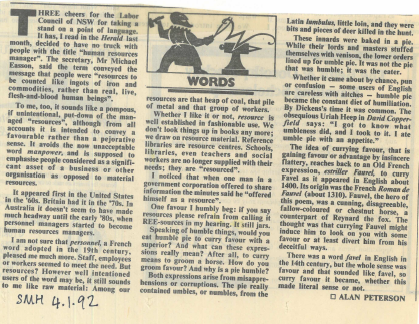
Finally, it is noteworthy that politics always attracts more candidates than positions available. In 1994 I stuck my hand up for the Senate, when Graham Richardson resigned. I got rolled. It is a long story, worth telling separately one day.
In leaving, my imperative was to ensure orderly succession. From Sams to Lennon, for 22 years all my successors as Secretaries of the Labor Council (in 2004 renamed as Unions NSW) had worked with me.
At a farewell dinner in July 1994, after various speeches were given, I was reminded of a story about George Bernard Shaw on the opening night of his play Back to Methuselah, which had been greeted by roars of approval from the audience. The playwright was greeted with thunderous applause, a spotlight following him as he centred at the front of the stage. One dissenter shouted: “I thought it was awful.” Shaw agreed: “But who are we against so many?” he asked. In my retelling that story, I remembered what John Whelan told me: keep them laughing, they will forgive you more.
A Montage of Photos
